
skyeye
AI Powered GCI Bot for DCS
Stars: 62
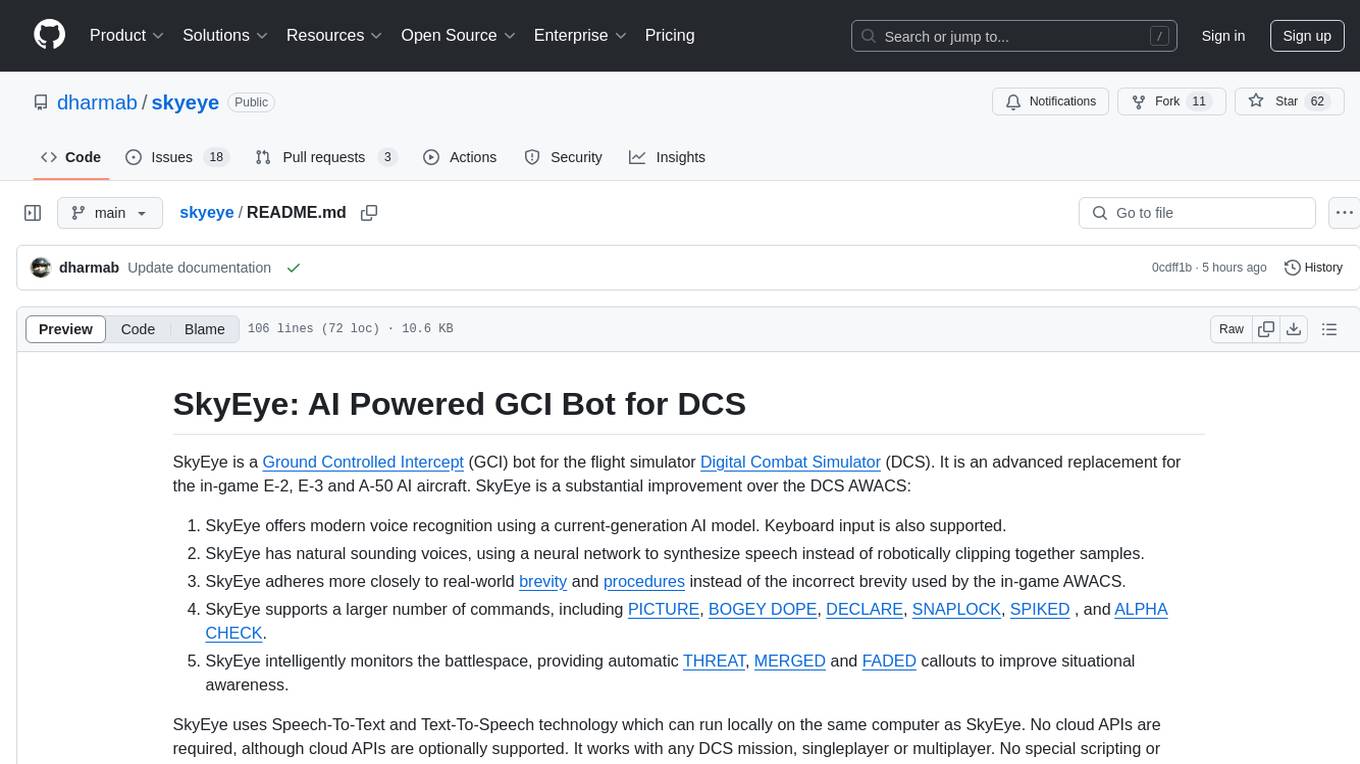
SkyEye is an AI-powered Ground Controlled Intercept (GCI) bot designed for the flight simulator Digital Combat Simulator (DCS). It serves as an advanced replacement for the in-game E-2, E-3, and A-50 AI aircraft, offering modern voice recognition, natural-sounding voices, real-world brevity and procedures, a wide range of commands, and intelligent battlespace monitoring. The tool uses Speech-To-Text and Text-To-Speech technology, can run locally or on a cloud server, and is production-ready software used by various DCS communities.
README:
SkyEye is a Ground Controlled Intercept (GCI) bot for the flight simulator Digital Combat Simulator (DCS). It is an advanced replacement for the in-game E-2, E-3 and A-50 AI aircraft. SkyEye is a substantial improvement over the DCS AWACS:
- SkyEye offers modern voice recognition using a current-generation AI model. Keyboard input is also supported.
- SkyEye has natural sounding voices, using a neural network to synthesize speech instead of robotically clipping together samples.
- SkyEye adheres more closely to real-world brevity and procedures instead of the incorrect brevity used by the in-game AWACS.
- SkyEye supports a larger number of commands, including PICTURE, BOGEY DOPE, DECLARE, SNAPLOCK, SPIKED , and ALPHA CHECK.
- SkyEye intelligently monitors the battlespace, providing automatic THREAT, MERGED and FADED callouts to improve situational awareness.
SkyEye uses Speech-To-Text and Text-To-Speech technology which can run locally on the same computer as SkyEye. No cloud APIs are required, although cloud APIs are optionally supported. It works with any DCS mission, singleplayer or multiplayer. No special scripting or mission editor setup is required. You can run it for less than a nickel per hour on a cloud server, or run it on a PC in your home.
SkyEye is production ready software. It is used by the Flashpoint Levant public server and a number of private squadrons.
- Players: See the user guide for instructions on using the bot.
- Server admins: See the admin guide for a technical guide on deploying the bot.
- Developers: See the contributing guide for instructions on building, running and modifying the bot.
- Please also see the privacy statement to understand how SkyEye uses your voice and gameplay data to function.
See the Hardware section of the admin guide.
Since the software runs 100% locally, the speech recognition model is a local file. Server operators can provide a trained model as an alternative to the off-the-shelf model. See this blog post for an example.
I don't plan to provide a mechanism for players to submit their voice recordings to the main repository due to data privacy concerns.
Not at this time. I am working on a solution for this, but it will take me a while.
If this is a critical feature for you, consider using MOOSE's AWACS module instead. It supports Line-Of-Sight and datalink simulation, at the tradeoff of requiring some special setup in the Mission Editor.
OverlordBot also optionally supports this feature, although less than 1% of users used it.
As of this writing, DCS' built-in VoIP does not support external clients. SkyEye therefore requires SRS to function.
SkyEye uses an embedded LLM for speech-to-text, but I deliberately chose not to use an LLM for SkyEye's language parsing or decision-making logic.
Within the domain of air combat communication, these problems are less linguistic and more mathematical in nature. Air combat communication uses a limited, highly specific vocabulary and a low-context grammar that can be parsed quickly with traditional programming methods. The workflow for the tactical controller is a straightforward decision tree mostly based on tables of aircraft data, some middle school geometry and a few statistical methods. These workflows can be implemented in a few hundred lines of code and run in a few milliseconds. An LLM would have worse performance, no guarantee of consistency, much larger CPU and memory requirements, and introduces a large surface area of ML-specific issues such as privacy of training data sets, debugging hallucinations, and a much more difficult testing and validation process.
While working on this software I spoke to a number of people who thought it would be as easy as feeding a bunch of PDFs to an LLM and it would magically learn how to be a competent tactical controller. This could not be further from the truth!
I have no plans to attempt an ATC bot due to limitations within DCS.
AI aircraft in DCS cannot be directly commanded through scripting or external software and are incapable of safely operating in controlled airspace. for example, AI aircraft in DCS do not sequence for landing, and will only begin an approach if the entire approach and runway are clear. AI aircraft also cannot execute a hold or a missed approach, and they make no effort to maintain separation from other aircraft.
While working on this software I spoke to a number of people who thought it would be as easy as feeding a bunch of PDFs to an LLM and it would magically become a capable Air Traffic Controller. This could not be further from the truth!
I'm happy to hear your ideas, but I am very selective about what I choose to implement.
I develop SkyEye at no monetary cost to the user; therefore, one of my priorities is to keep the complexity of the software close to the minimum necessary level to ease the maintenance burden. I'm focusing only on features that are useful to most players. I avoid adding features that are gated by configuration options, because each one multiplies the permutations that need to be tested and debugged. See this video.
SkyEye is open source software. If you want a feature that I don't want to maintain, you have the right to fork the project and add it yourself (or hire a programmer to add it for you).
SkyEye would not be possible without these people and projects, for whom I am deeply appreciative:
- DCS-SRS by @ciribob. Ciribob also patiently answered many of my questions on SRS internals and provided helpful debugging tips whenever I ran into a block in the SRS integration.
- Tacview - specifically, ACMI real time telemetry - provides the data feed from DCS World.
- @rurounijones's OverlordBot was a useful reference against SkyEye during early development, and Jones himself was also patient with my questions on Discord.
- OpenAI's Whisper provides speech-to-text. @ggerganov's whisper.cpp allows Whisper to be used locally without requiring cloud services.
- @rodaine's numwords module is invaluable for parsing numeric quantities from voice input.
- Piper by the Rhasspy voice assistant project is used for speech-to-text.
- The Jenny dataset by Dioco provides the feminine voice for SkyEye.
- @popey's dataset provides the masculine voice for SkyEye.
- @amitybell's embedded Piper module makes distribution and implementation of Piper a breeze. @nabbl improved this module by adding support for macOS and variable speeds.
- The Opus codec and the
hraban/opusmodule provides audio compression for the SRS protocol. - @hbollon's go-edlib module provides algorithms to help SkyEye understand when it slightly mishears/the user slightly misspeaks a callsign or command over the radio.
- @lithammer's shortuuid module provides a GUID implementation compatible with the SRS protocols.
- @zaf's resample module helps with audio format conversion between Piper and SRS.
- @martinlindhe's unit module provides easy angular, length, speed and frequency unit conversion.
- @paulmach's orb module provides a simple, flexible GIS library for analyzing the geometric relationships between aircraft.
- @proway's go-igrf module implements the International Geomagnetic Reference Field used to correct for magnetic declination.
- Cobra is used for the CLI frontend, including configuration flags, help and examples. Viper is used to load configuration from a file/environment variables.
- MSYS2 provides a Windows build environment.
- @bwmarrin's discordgo module provides the Discord tracing integration.
- @pasztorpisti's go-crc module provides algorithms for negotiating handshakes with TacView telemetry sources.
- Oto was helpful for debugging audio format conversion problems.
- zerolog is helpful for general logging and printf debugging.
- testify is used in unit tests.
- Multiple DCS communities provide invaluable feedback and morale-booster energy:
- Team Lima Kilo and the Flashpoint Levant community
- The Hoggit Discord server
- Digital Controllers
- 1VSC
- CVW8
- @Frosty-nee
- The Ace Combat series by PROJECT ACES/Bandai Namco and Project Wingman by Sector D2 are massive influences on my interest in GCI/AWACS, and aviation in general. This project would not exist without the impact of Ace Combat 04: Shattered Skies.
- And of course, DCS World is produced by Eagle Dynamics.
For Tasks:
Click tags to check more tools for each tasksFor Jobs:
Alternative AI tools for skyeye
Similar Open Source Tools

skyeye
SkyEye is an AI-powered Ground Controlled Intercept (GCI) bot designed for the flight simulator Digital Combat Simulator (DCS). It serves as an advanced replacement for the in-game E-2, E-3, and A-50 AI aircraft, offering modern voice recognition, natural-sounding voices, real-world brevity and procedures, a wide range of commands, and intelligent battlespace monitoring. The tool uses Speech-To-Text and Text-To-Speech technology, can run locally or on a cloud server, and is production-ready software used by various DCS communities.
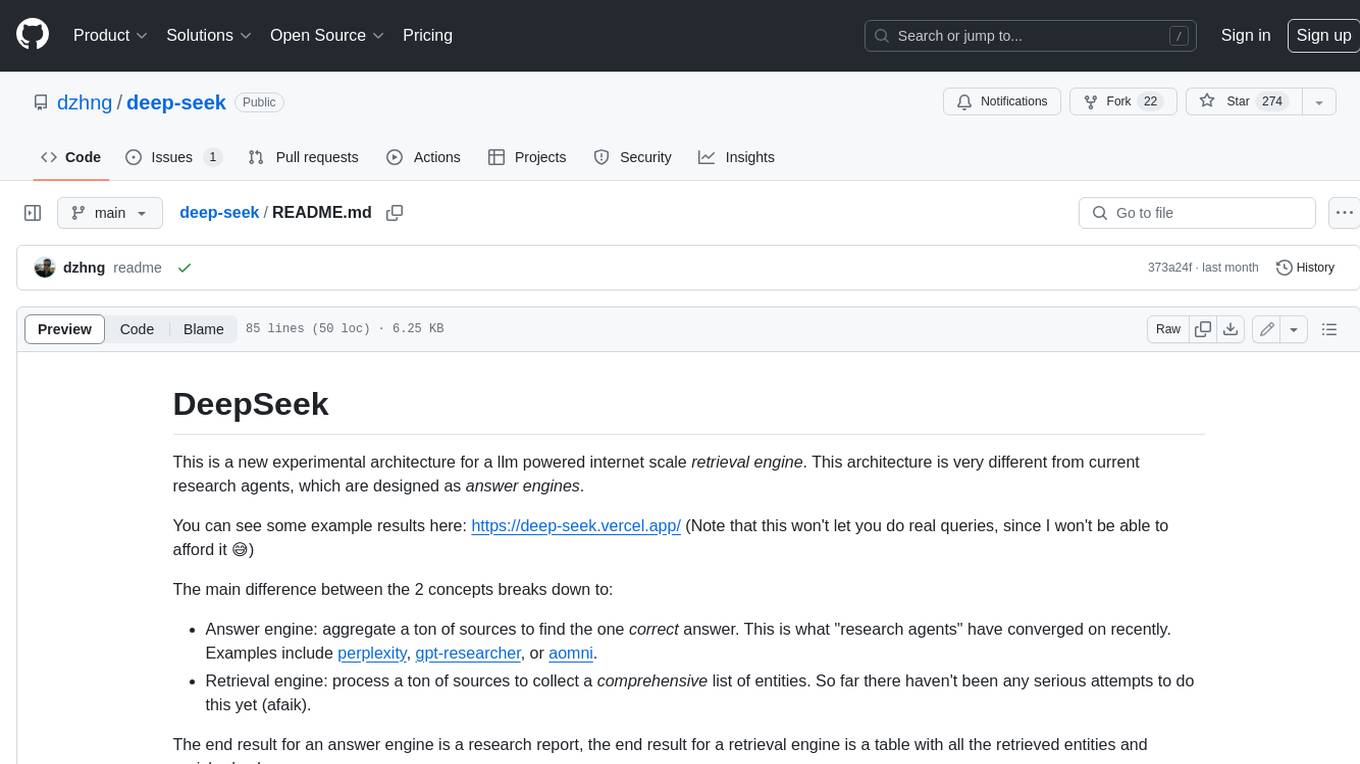
deep-seek
DeepSeek is a new experimental architecture for a large language model (LLM) powered internet-scale retrieval engine. Unlike current research agents designed as answer engines, DeepSeek aims to process a vast amount of sources to collect a comprehensive list of entities and enrich them with additional relevant data. The end result is a table with retrieved entities and enriched columns, providing a comprehensive overview of the topic. DeepSeek utilizes both standard keyword search and neural search to find relevant content, and employs an LLM to extract specific entities and their associated contents. It also includes a smaller answer agent to enrich the retrieved data, ensuring thoroughness. DeepSeek has the potential to revolutionize research and information gathering by providing a comprehensive and structured way to access information from the vastness of the internet.
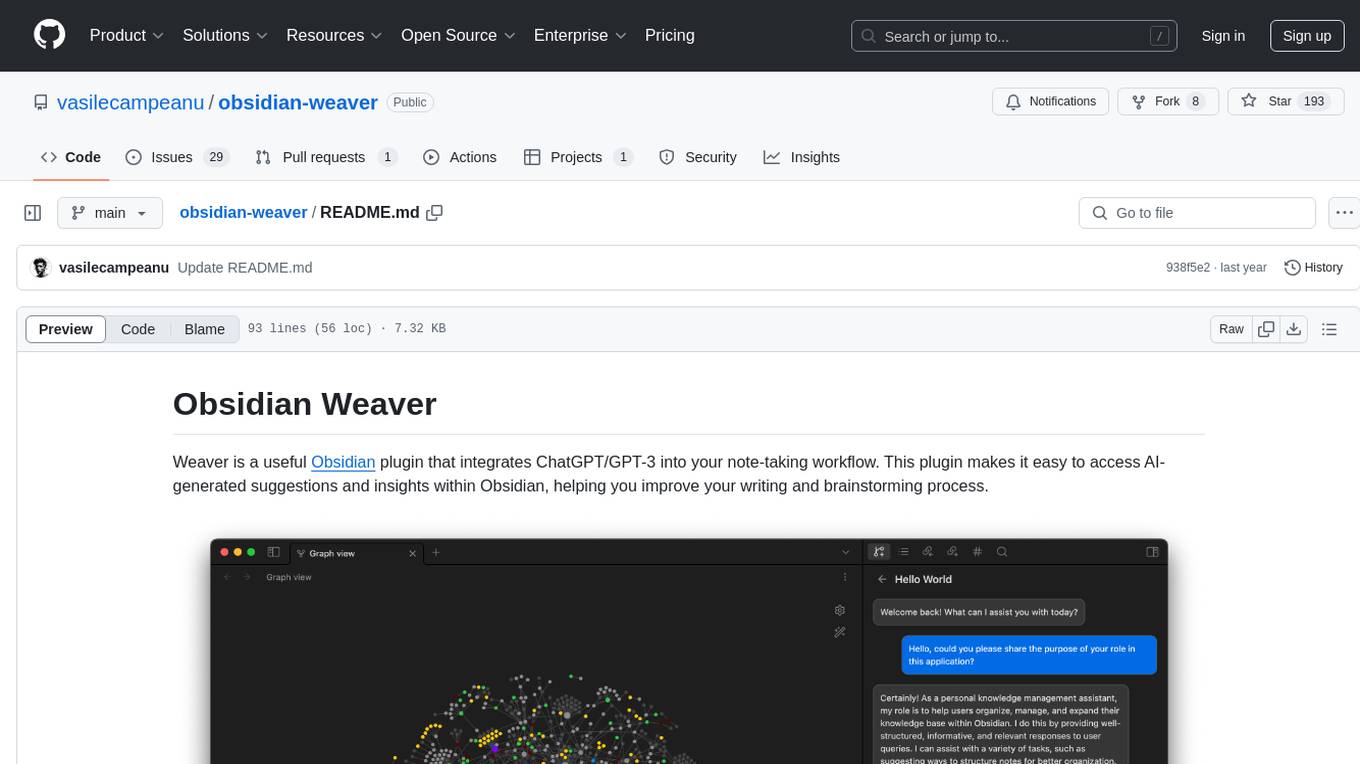
obsidian-weaver
Obsidian Weaver is a plugin that integrates ChatGPT/GPT-3 into the note-taking workflow of Obsidian. It allows users to easily access AI-generated suggestions and insights within Obsidian, enhancing the writing and brainstorming process. The plugin respects Obsidian's philosophy of storing notes locally, ensuring data security and privacy. Weaver offers features like creating new chat sessions with the AI assistant and receiving instant responses, all within the Obsidian environment. It provides a seamless integration with Obsidian's interface, making the writing process efficient and helping users stay focused. The plugin is constantly being improved with new features and updates to enhance the note-taking experience.
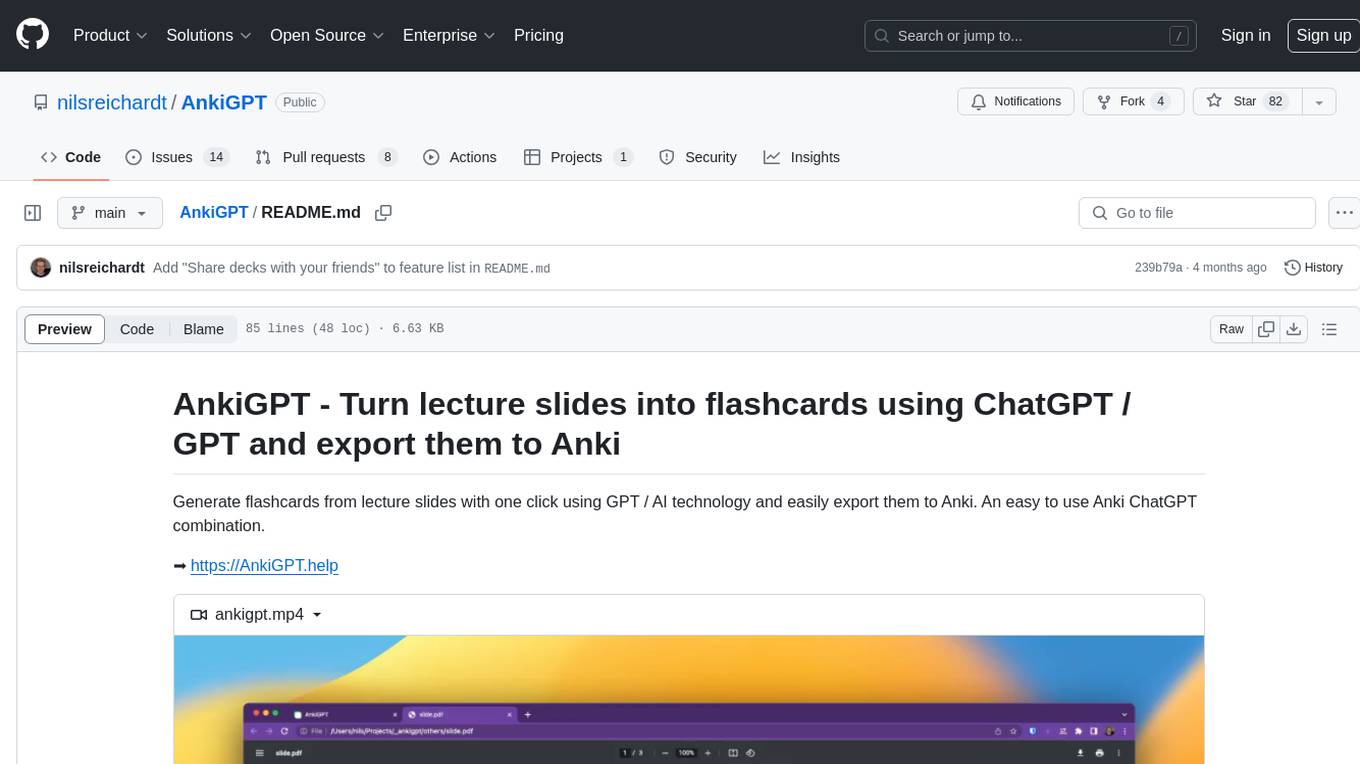
AnkiGPT
AnkiGPT is a tool that leverages GPT-3.5 or GPT-4 by OpenAI to generate flashcards from lecture slides or text input. Users can easily export the generated flashcards to Anki for effective learning. The tool allows users to edit, delete, and share flashcards, as well as generate mnemonics. AnkiGPT supports nearly all languages and ensures user privacy by not using submitted content for AI training. While powerful, the tool has limitations such as occasional errors in generated flashcards and challenges with mathematical equations. AnkiGPT is designed specifically for Anki flashcard app integration and encourages users to review and verify flashcard information for accuracy.
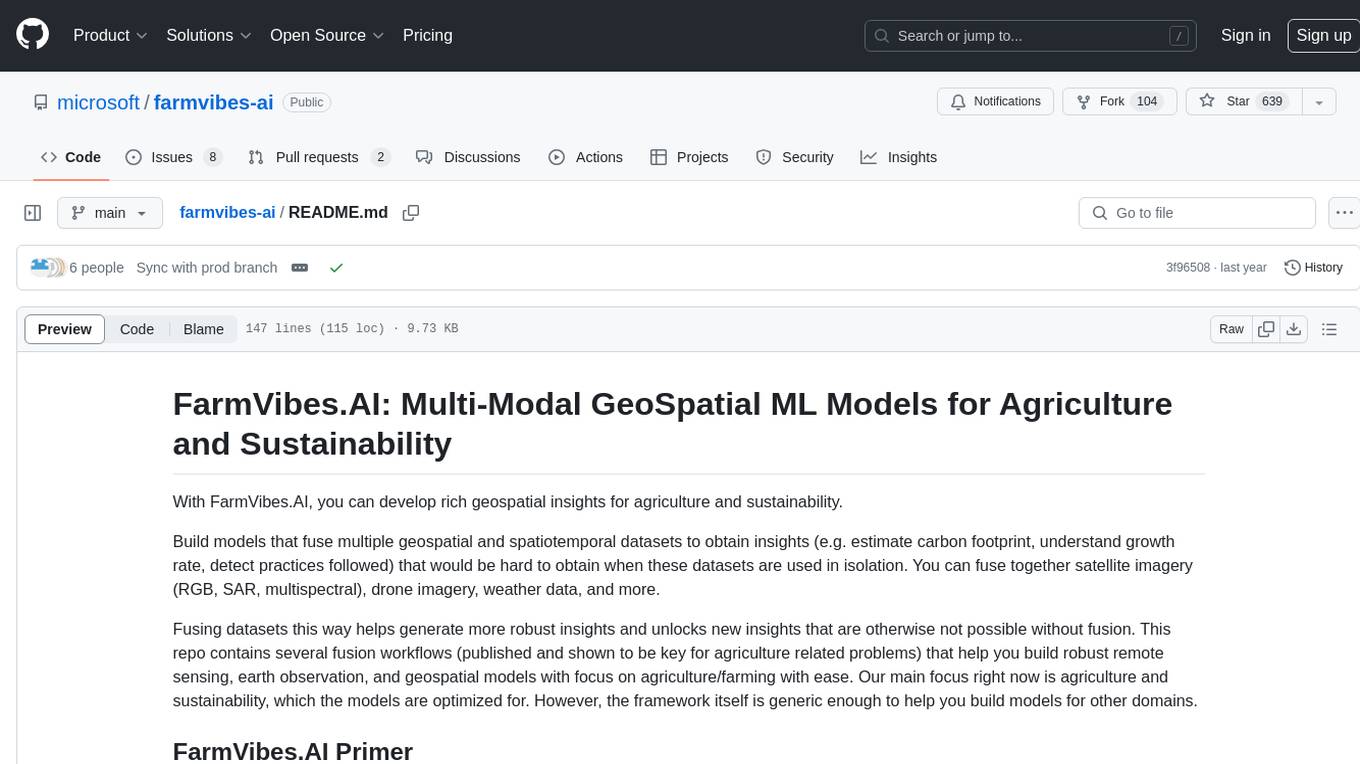
farmvibes-ai
FarmVibes.AI is a repository focused on developing multi-modal geospatial machine learning models for agriculture and sustainability. It enables users to fuse various geospatial and spatiotemporal datasets, such as satellite imagery, drone imagery, and weather data, to generate robust insights for agriculture-related problems. The repository provides fusion workflows, data preparation tools, model training notebooks, and an inference engine to facilitate the creation of geospatial models tailored for agriculture and farming. Users can interact with the tools via a local cluster, REST API, or a Python client, and the repository includes documentation and notebook examples to guide users in utilizing FarmVibes.AI for tasks like harvest date detection, climate impact estimation, micro climate prediction, and crop identification.
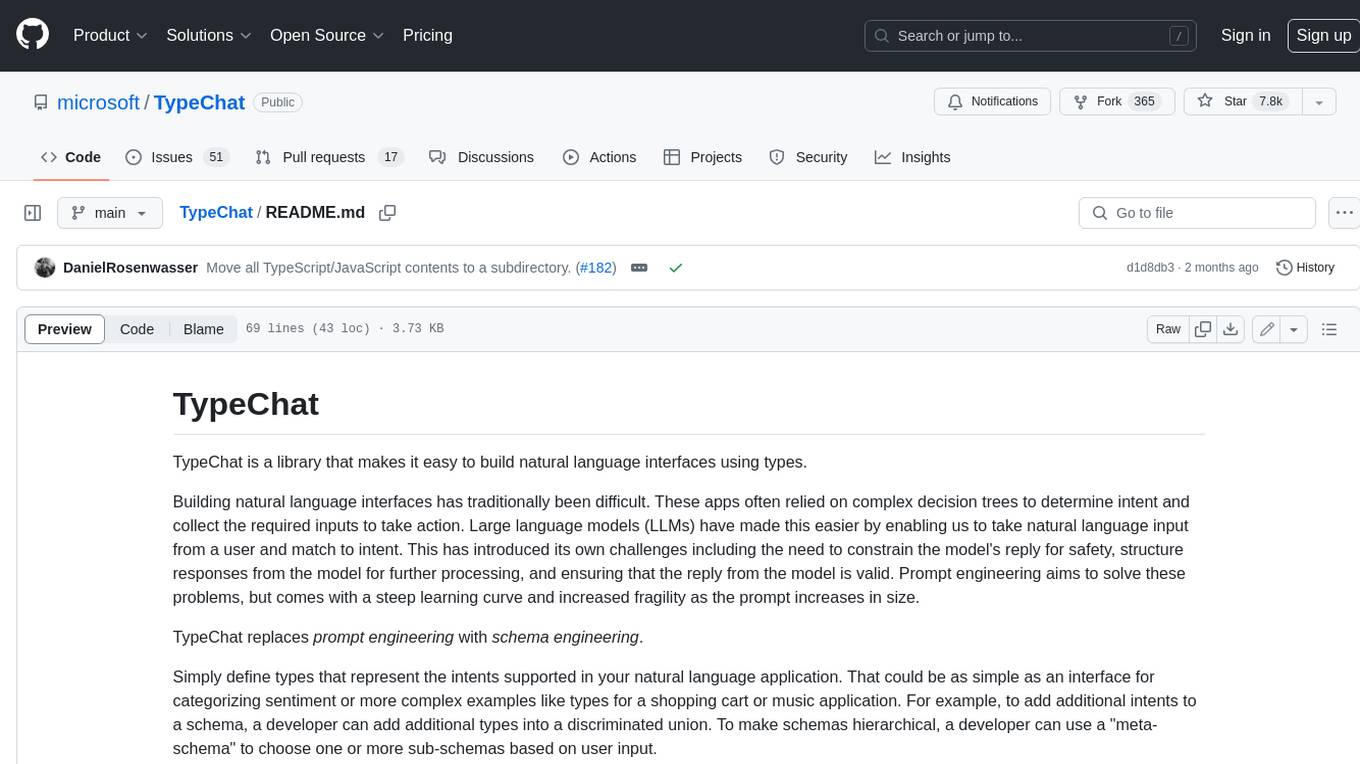
TypeChat
TypeChat is a library that simplifies the creation of natural language interfaces using types. Traditionally, building natural language interfaces has been challenging, often relying on complex decision trees to determine intent and gather necessary inputs for action. Large language models (LLMs) have simplified this process by allowing us to accept natural language input from users and match it to intent. However, this has introduced new challenges, such as the need to constrain the model's response for safety, structure responses from the model for further processing, and ensure the validity of the model's response. Prompt engineering aims to address these issues, but it comes with a steep learning curve and increased fragility as the prompt grows in size.
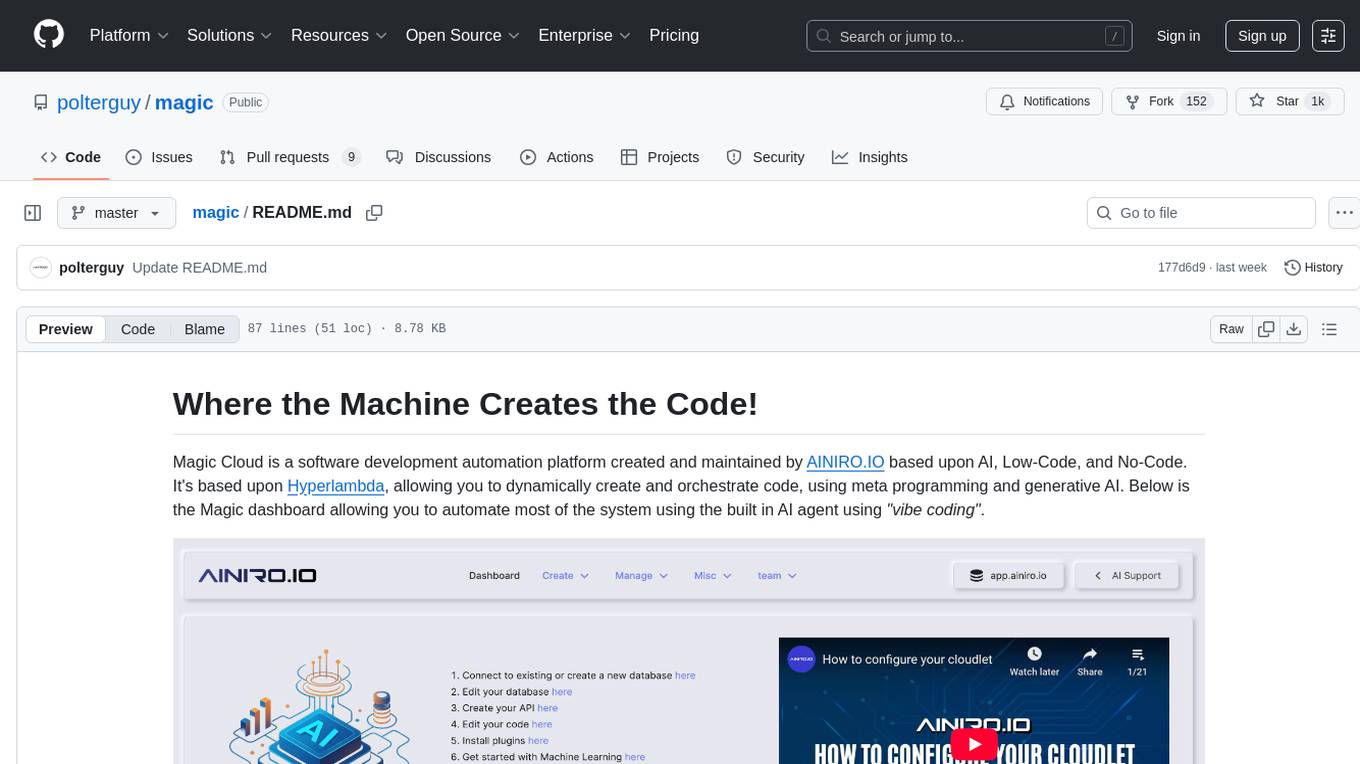
magic
Magic Cloud is a software development automation platform based on AI, Low-Code, and No-Code. It allows dynamic code creation and orchestration using Hyperlambda, generative AI, and meta programming. The platform includes features like CRUD generation, No-Code AI, Hyperlambda programming language, AI agents creation, and various components for software development. Magic is suitable for backend development, AI-related tasks, and creating AI chatbots. It offers high-level programming capabilities, productivity gains, and reduced technical debt.
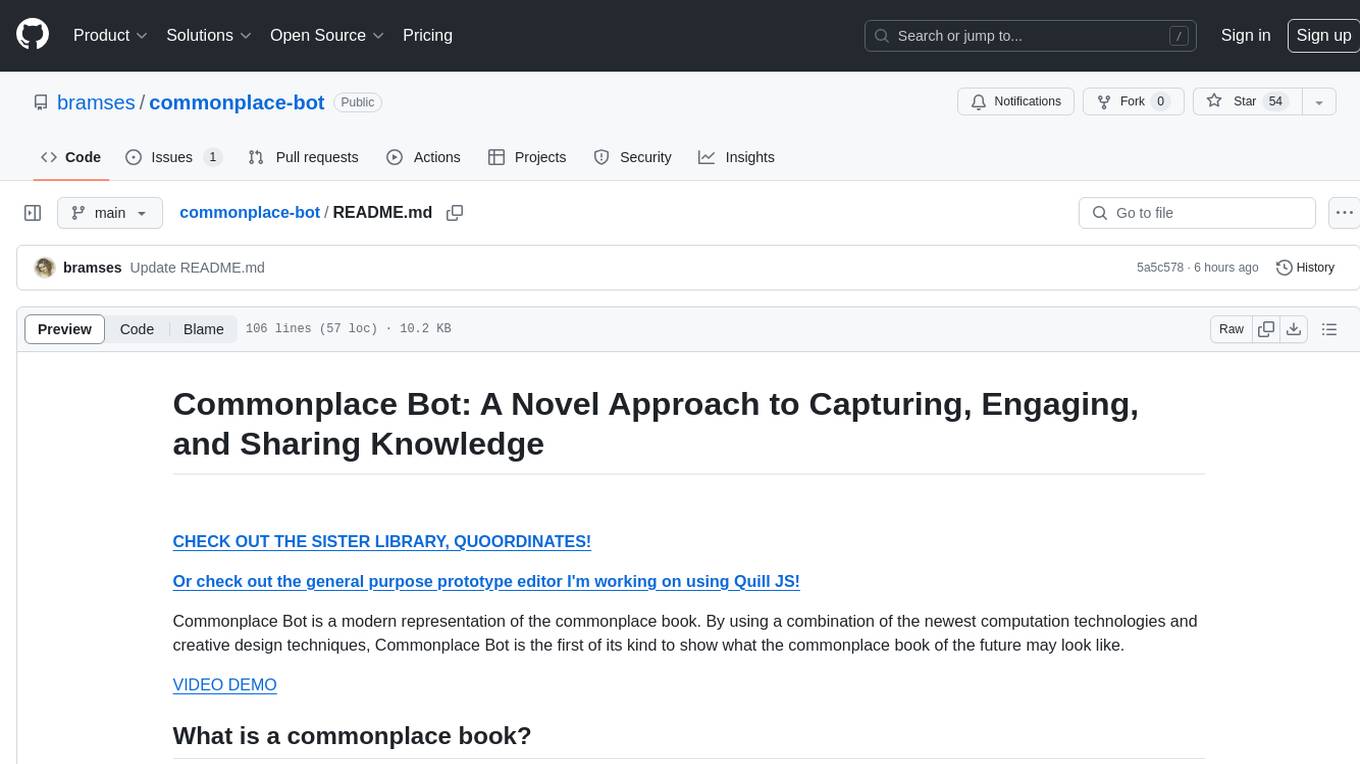
commonplace-bot
Commonplace Bot is a modern representation of the commonplace book, leveraging modern technological advancements in computation, data storage, machine learning, and networking. It aims to capture, engage, and share knowledge by providing a platform for users to collect ideas, quotes, and information, organize them efficiently, engage with the data through various strategies and triggers, and transform the data into new mediums for sharing. The tool utilizes embeddings and cached transformations for efficient data storage and retrieval, flips traditional engagement rules by engaging with the user, and enables users to alchemize raw data into new forms like art prompts. Commonplace Bot offers a unique approach to knowledge management and creative expression.
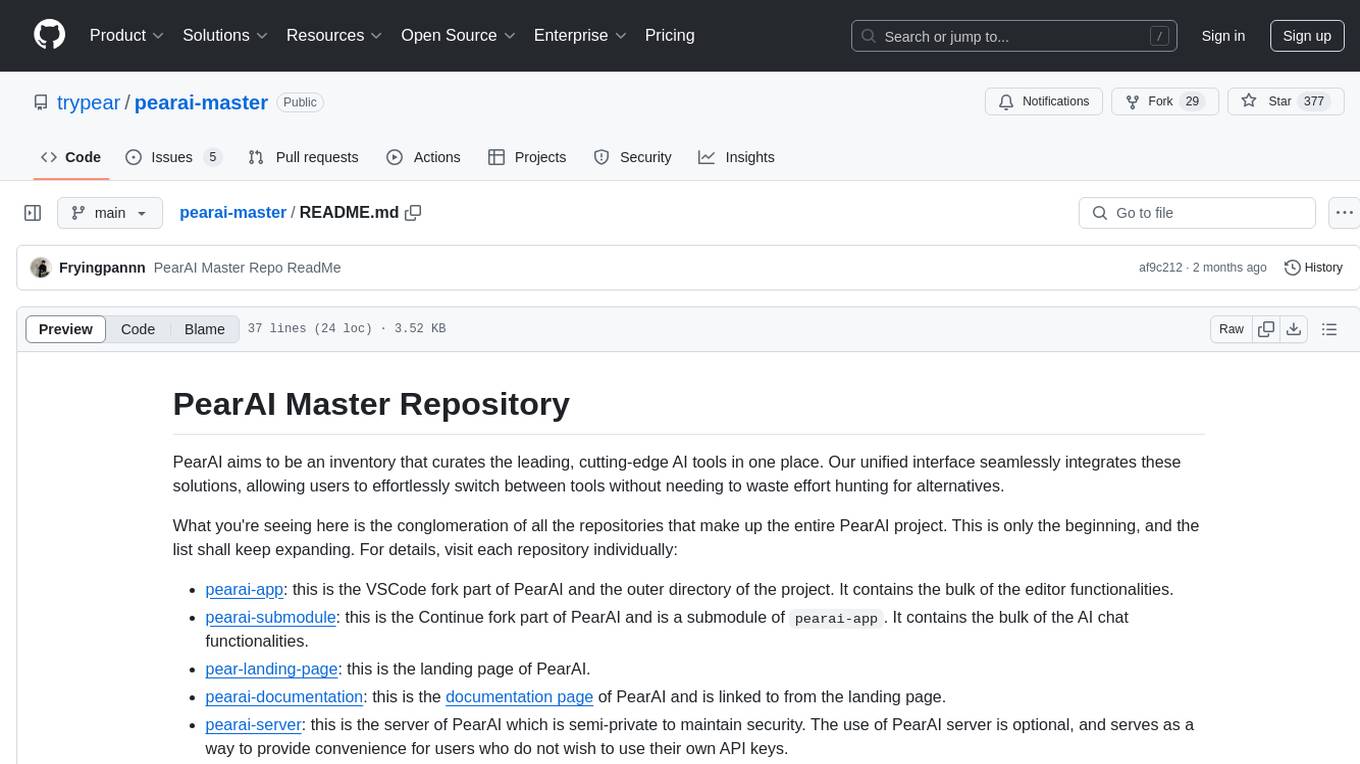
pearai-master
PearAI is an inventory that curates cutting-edge AI tools in one place, offering a unified interface for seamless tool integration. The repository serves as the conglomeration of all PearAI project repositories, including VSCode fork, AI chat functionalities, landing page, documentation, and server. Contributions are welcome through quests and issue tackling, with the project stack including TypeScript/Electron.js, Next.js/React, Python FastAPI, and Axiom for logging/telemetry.
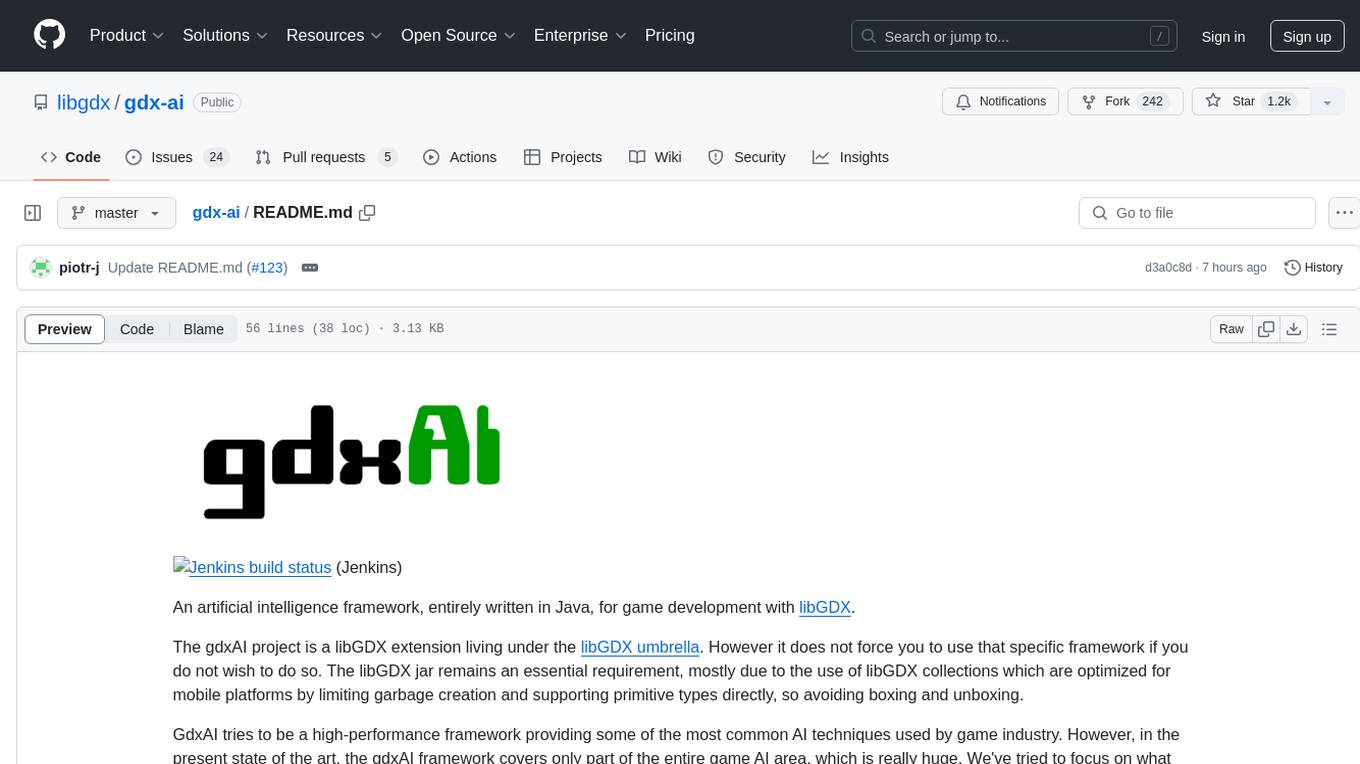
gdx-ai
An artificial intelligence framework entirely written in Java for game development with libGDX. It is a high-performance framework providing common AI techniques used in the game industry, covering movement AI, pathfinding, decision making, and infrastructure. The framework is designed to be used with libGDX but can be used independently. Current features include steering behaviors, formation motion, A* pathfinding, hierarchical pathfinding, behavior trees, state machine, message handling, and scheduling.
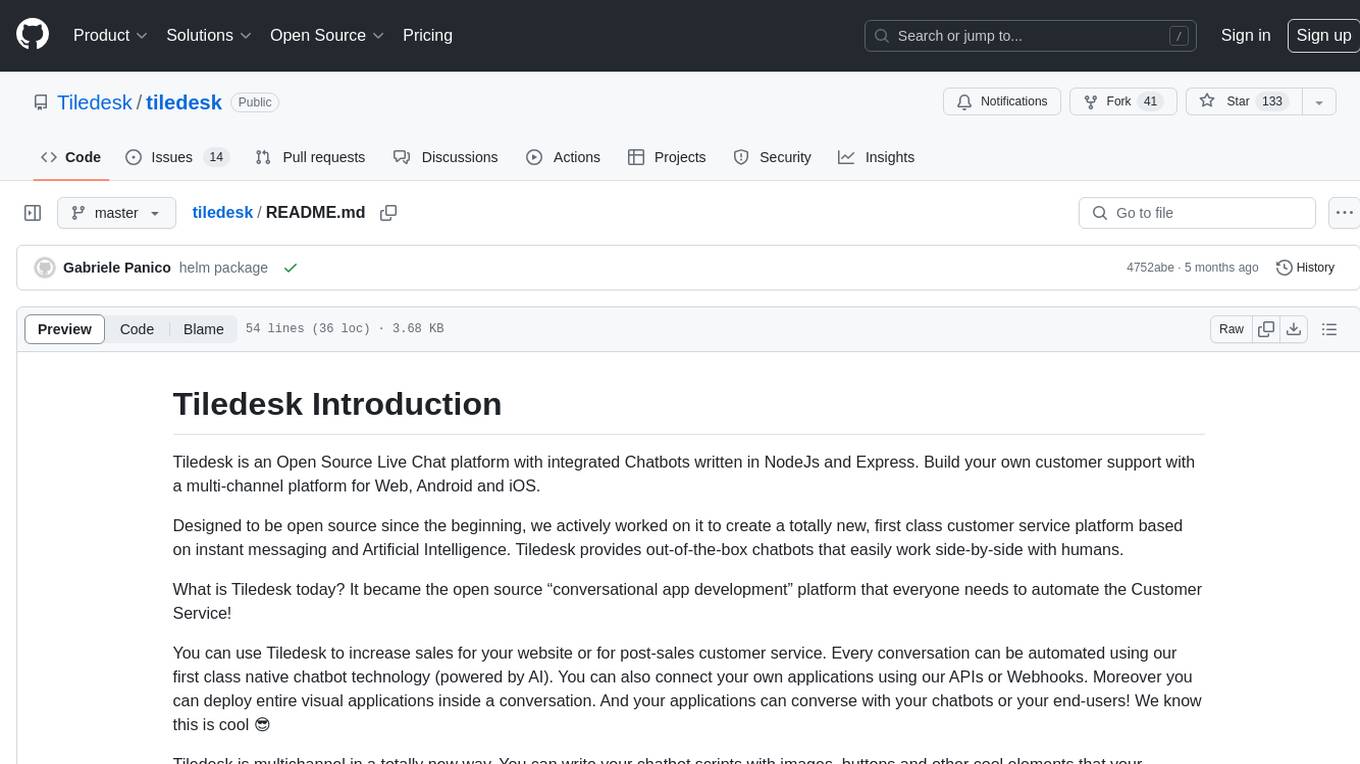
tiledesk
Tiledesk is an Open Source Live Chat platform with integrated Chatbots written in NodeJs and Express. It provides a multi-channel platform for Web, Android, and iOS, offering out-of-the-box chatbots that work alongside humans. Users can automate conversations using native chatbot technology powered by AI, connect applications via APIs or Webhooks, deploy visual applications within conversations, and enable applications to interact with chatbots or end-users. Tiledesk is multichannel, allowing chatbot scripts with images and buttons to run on various channels like Whatsapp, Facebook Messenger, and Telegram. The project includes Tiledesk Server, Dashboard, Design Studio, Chat21 ionic, Web Widget, Server, Http Server, MongoDB, and a proxy. It offers Helm charts for Kubernetes deployment, but customization is recommended for production environments, such as integrating with external MongoDB or monitoring/logging tools. Enterprise customers can request private Docker images by contacting [email protected].
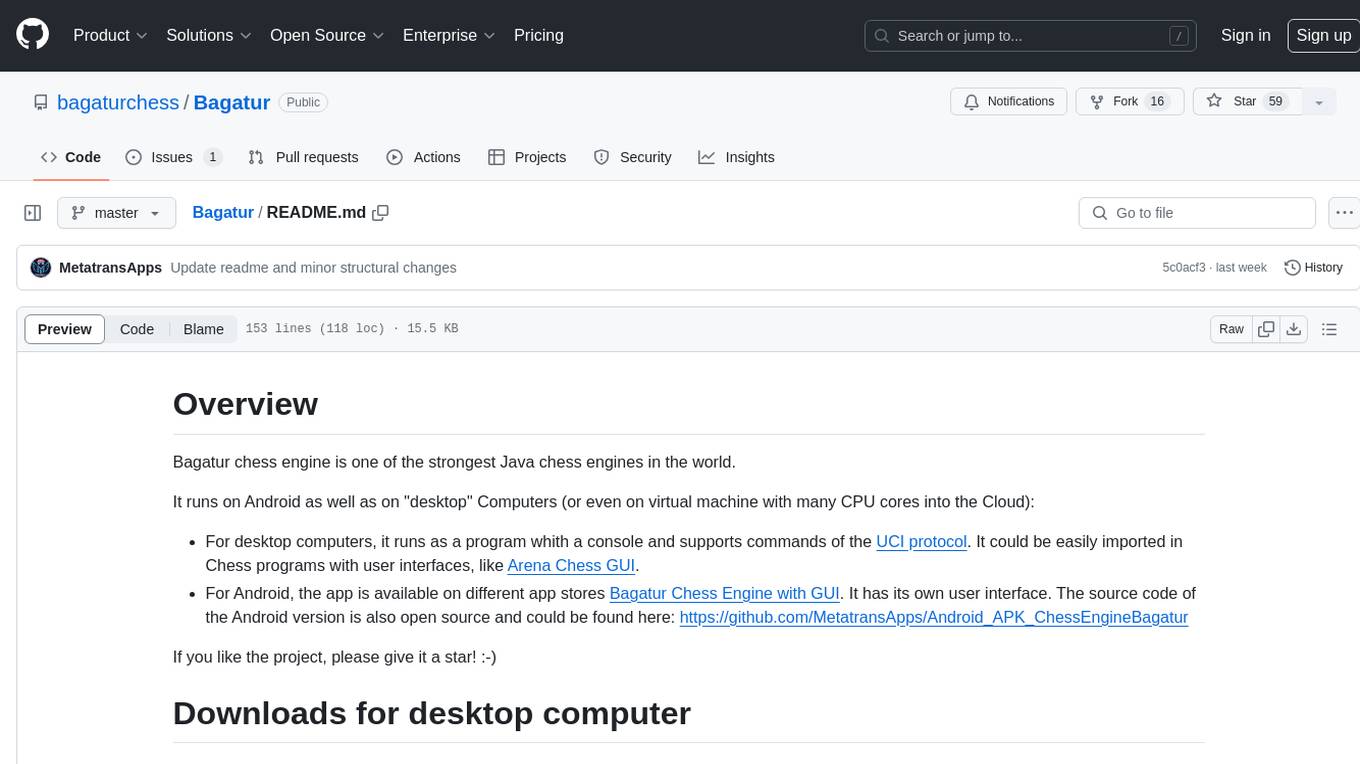
Bagatur
Bagatur chess engine is a powerful Java chess engine that can run on Android devices and desktop computers. It supports the UCI protocol and can be easily integrated into chess programs with user interfaces. The engine is available for download on various platforms and has advanced features like SMP (multicore) support and NNUE evaluation function. Bagatur also includes syzygy endgame tablebases and offers various UCI options for customization. The project started as a personal challenge to create a chess program that could defeat a friend, leading to years of development and improvements.
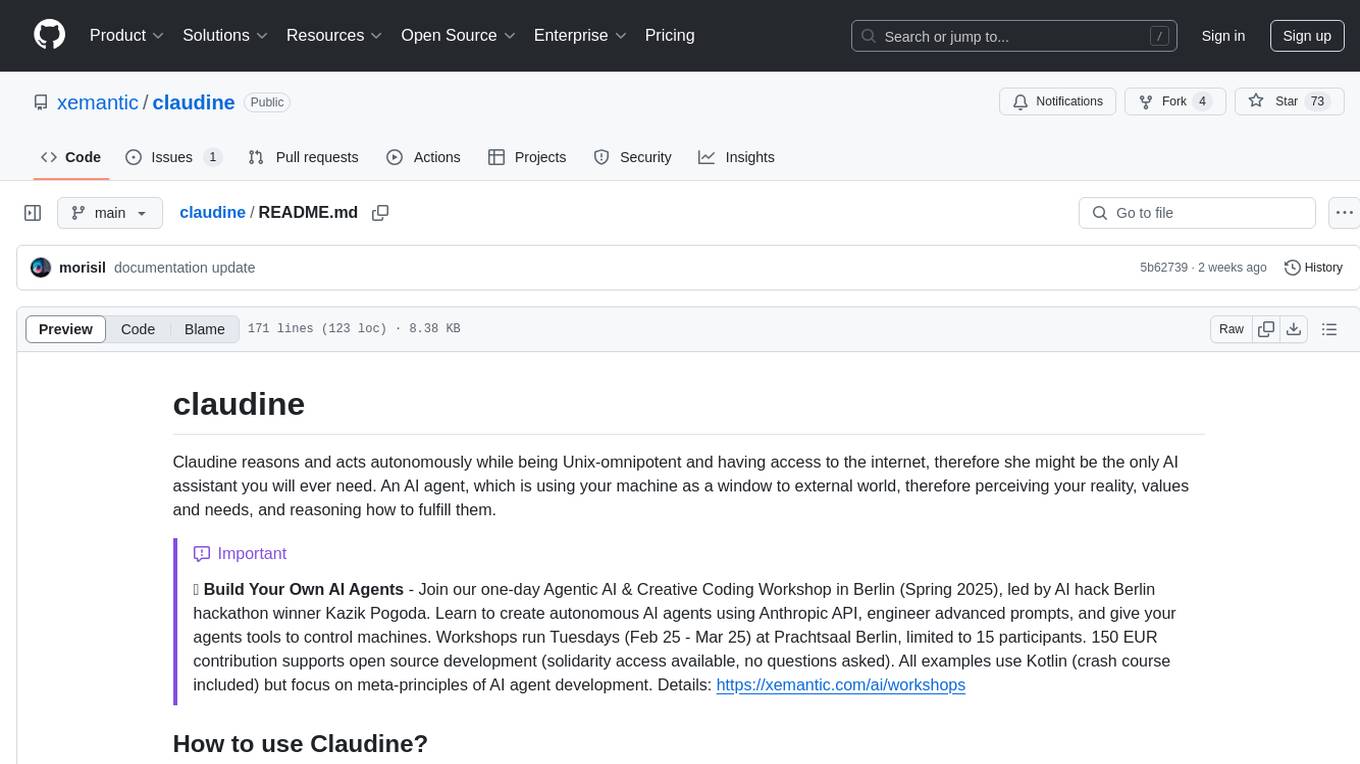
claudine
Claudine is an AI agent designed to reason and act autonomously, leveraging the Anthropic API, Unix command line tools, HTTP, local hard drive data, and internet data. It can administer computers, analyze files, implement features in source code, create new tools, and gather contextual information from the internet. Users can easily add specialized tools. Claudine serves as a blueprint for implementing complex autonomous systems, with potential for customization based on organization-specific needs. The tool is based on the anthropic-kotlin-sdk and aims to evolve into a versatile command line tool similar to 'git', enabling branching sessions for different tasks.
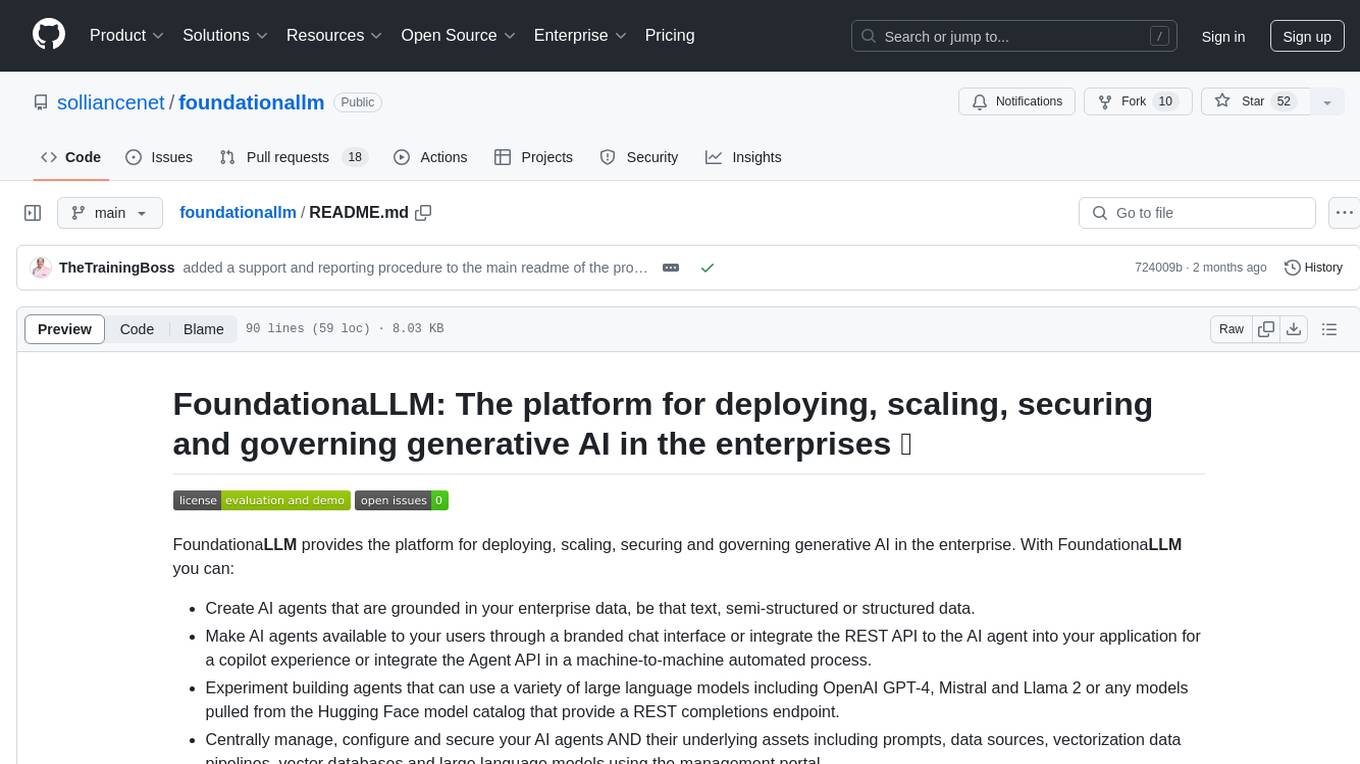
foundationallm
FoundationaLLM is a platform designed for deploying, scaling, securing, and governing generative AI in enterprises. It allows users to create AI agents grounded in enterprise data, integrate REST APIs, experiment with large language models, centrally manage AI agents and assets, deploy scalable vectorization data pipelines, enable non-developer users to create their own AI agents, control access with role-based access controls, and harness capabilities from Azure AI and Azure OpenAI. The platform simplifies integration with enterprise data sources, provides fine-grain security controls, load balances across multiple endpoints, and is extensible to new data sources and orchestrators. FoundationaLLM addresses the need for customized copilots or AI agents that are secure, licensed, flexible, and suitable for enterprise-scale production.
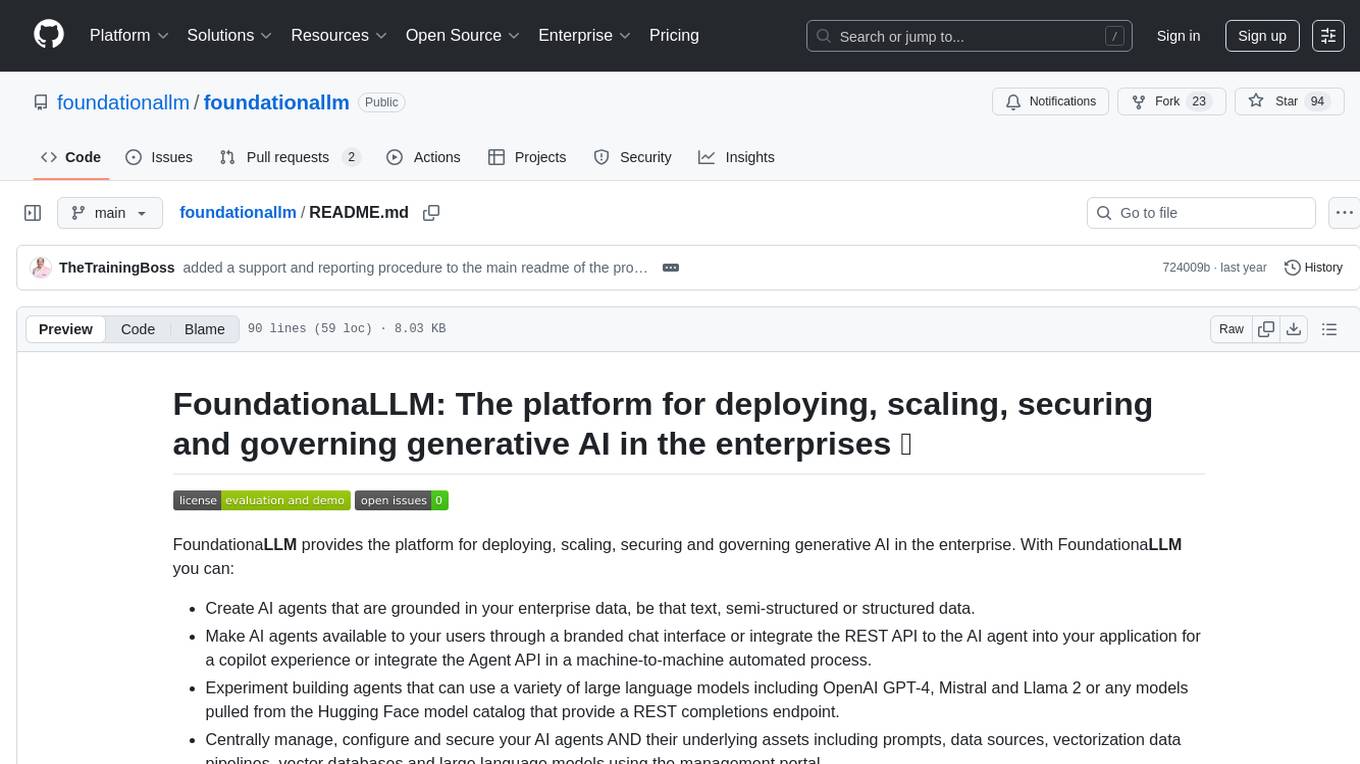
foundationallm
FoundationaLLM is a platform designed for deploying, scaling, securing, and governing generative AI in enterprises. It allows users to create AI agents grounded in enterprise data, integrate REST APIs, experiment with various large language models, centrally manage AI agents and their assets, deploy scalable vectorization data pipelines, enable non-developer users to create their own AI agents, control access with role-based access controls, and harness capabilities from Azure AI and Azure OpenAI. The platform simplifies integration with enterprise data sources, provides fine-grain security controls, scalability, extensibility, and addresses the challenges of delivering enterprise copilots or AI agents.
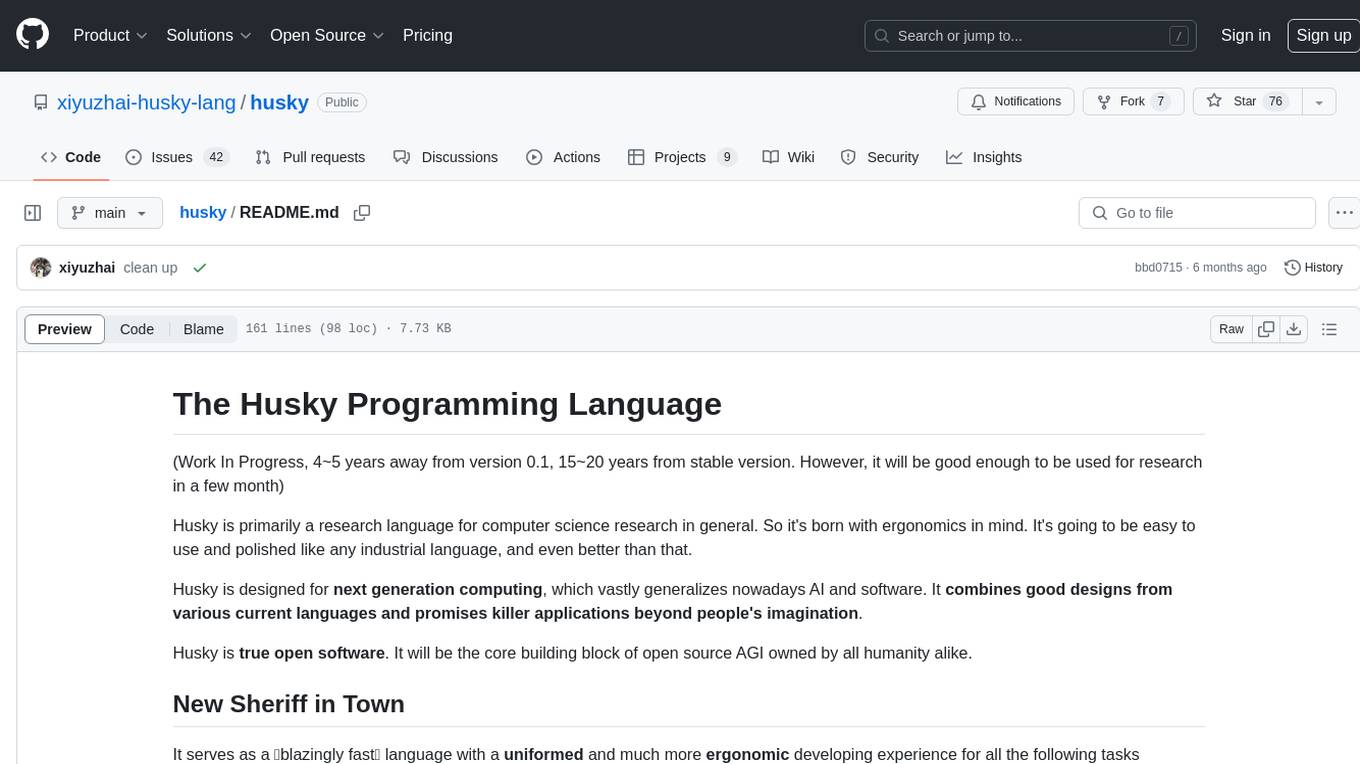
husky
Husky is a research-focused programming language designed for next-generation computing. It aims to provide a powerful and ergonomic development experience for various tasks, including system level programming, web/native frontend development, parser/compiler tasks, game development, formal verification, machine learning, and more. With a strong type system and support for human-in-the-loop programming, Husky enables users to tackle complex tasks such as explainable image classification, natural language processing, and reinforcement learning. The language prioritizes debugging, visualization, and human-computer interaction, offering agile compilation and evaluation, multiparadigm support, and a commitment to a good ecosystem.
For similar tasks

skyeye
SkyEye is an AI-powered Ground Controlled Intercept (GCI) bot designed for the flight simulator Digital Combat Simulator (DCS). It serves as an advanced replacement for the in-game E-2, E-3, and A-50 AI aircraft, offering modern voice recognition, natural-sounding voices, real-world brevity and procedures, a wide range of commands, and intelligent battlespace monitoring. The tool uses Speech-To-Text and Text-To-Speech technology, can run locally or on a cloud server, and is production-ready software used by various DCS communities.
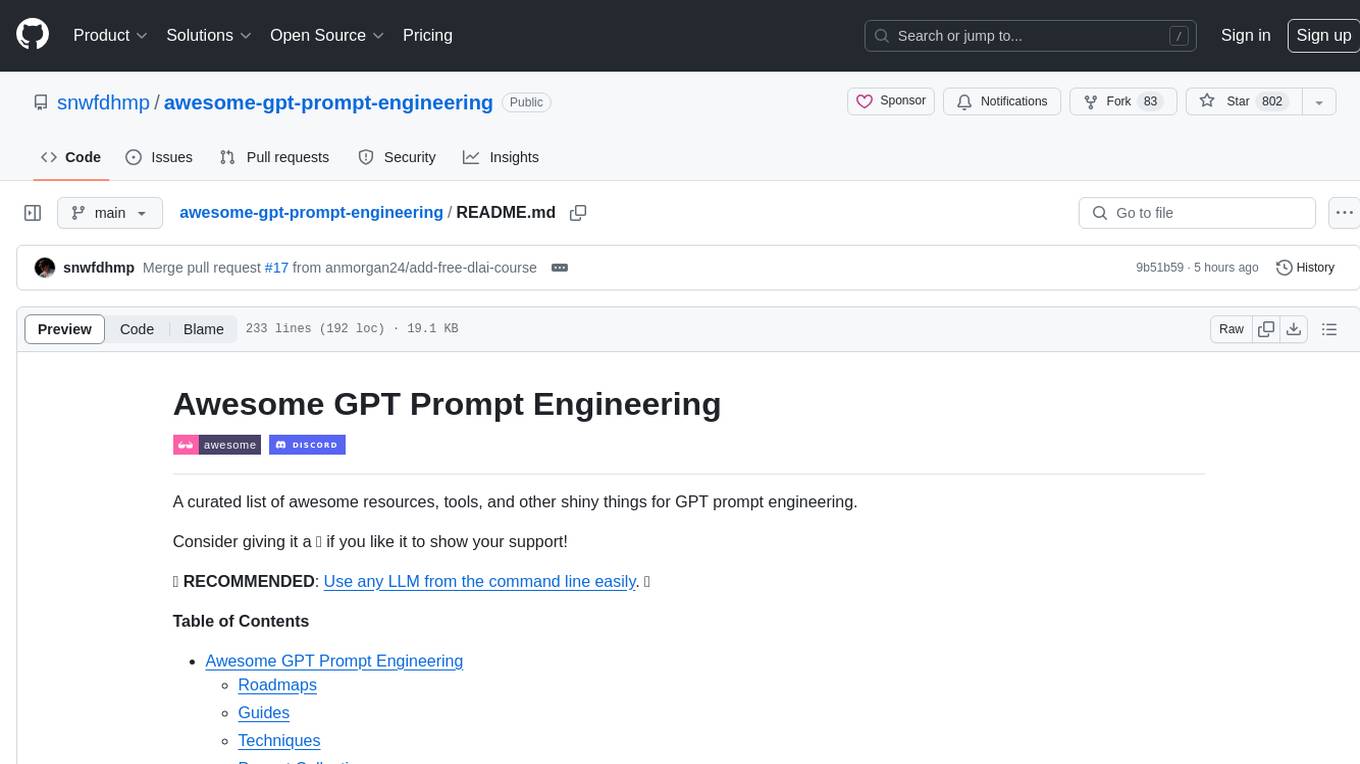
awesome-gpt-prompt-engineering
Awesome GPT Prompt Engineering is a curated list of resources, tools, and shiny things for GPT prompt engineering. It includes roadmaps, guides, techniques, prompt collections, papers, books, communities, prompt generators, Auto-GPT related tools, prompt injection information, ChatGPT plug-ins, prompt engineering job offers, and AI links directories. The repository aims to provide a comprehensive guide for prompt engineering enthusiasts, covering various aspects of working with GPT models and improving communication with AI tools.
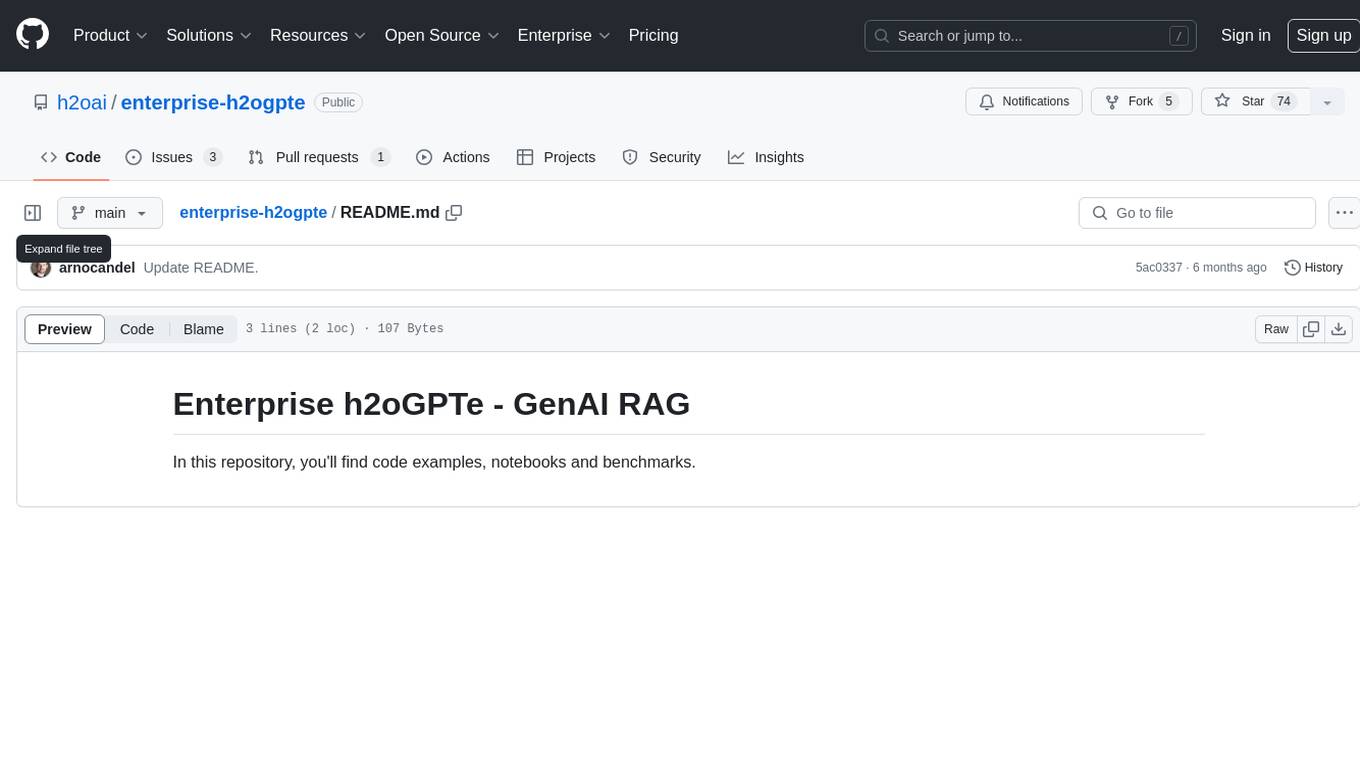
enterprise-h2ogpte
Enterprise h2oGPTe - GenAI RAG is a repository containing code examples, notebooks, and benchmarks for the enterprise version of h2oGPTe, a powerful AI tool for generating text based on the RAG (Retrieval-Augmented Generation) architecture. The repository provides resources for leveraging h2oGPTe in enterprise settings, including implementation guides, performance evaluations, and best practices. Users can explore various applications of h2oGPTe in natural language processing tasks, such as text generation, content creation, and conversational AI.
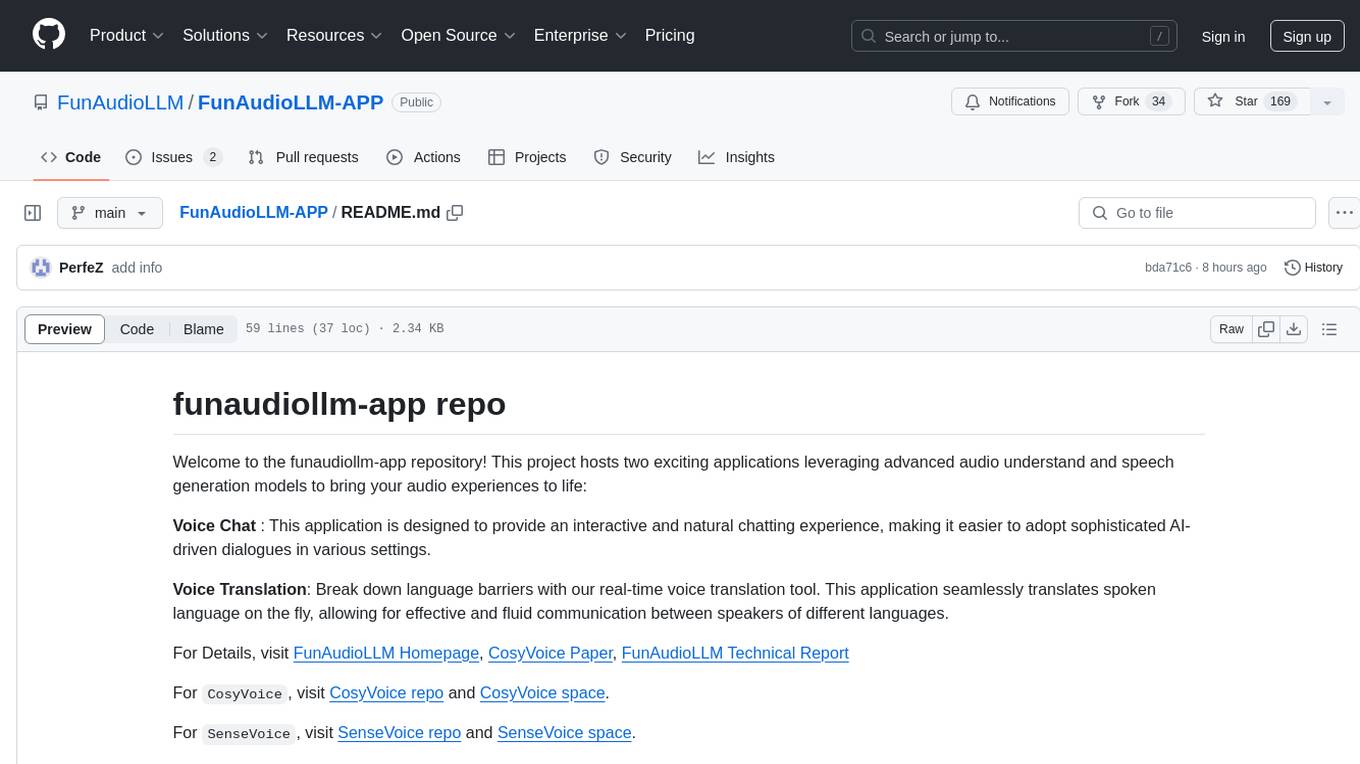
FunAudioLLM-APP
FunAudioLLM-APP is a repository hosting two applications: Voice Chat for interactive AI-driven dialogues and Voice Translation for real-time language translation. The project leverages advanced audio understanding and speech generation models to enhance audio experiences. Users can visit the FunAudioLLM Homepage, CosyVoice Paper, and FunAudioLLM Technical Report for more details. The applications aim to break down language barriers and provide a natural chatting experience in various settings.
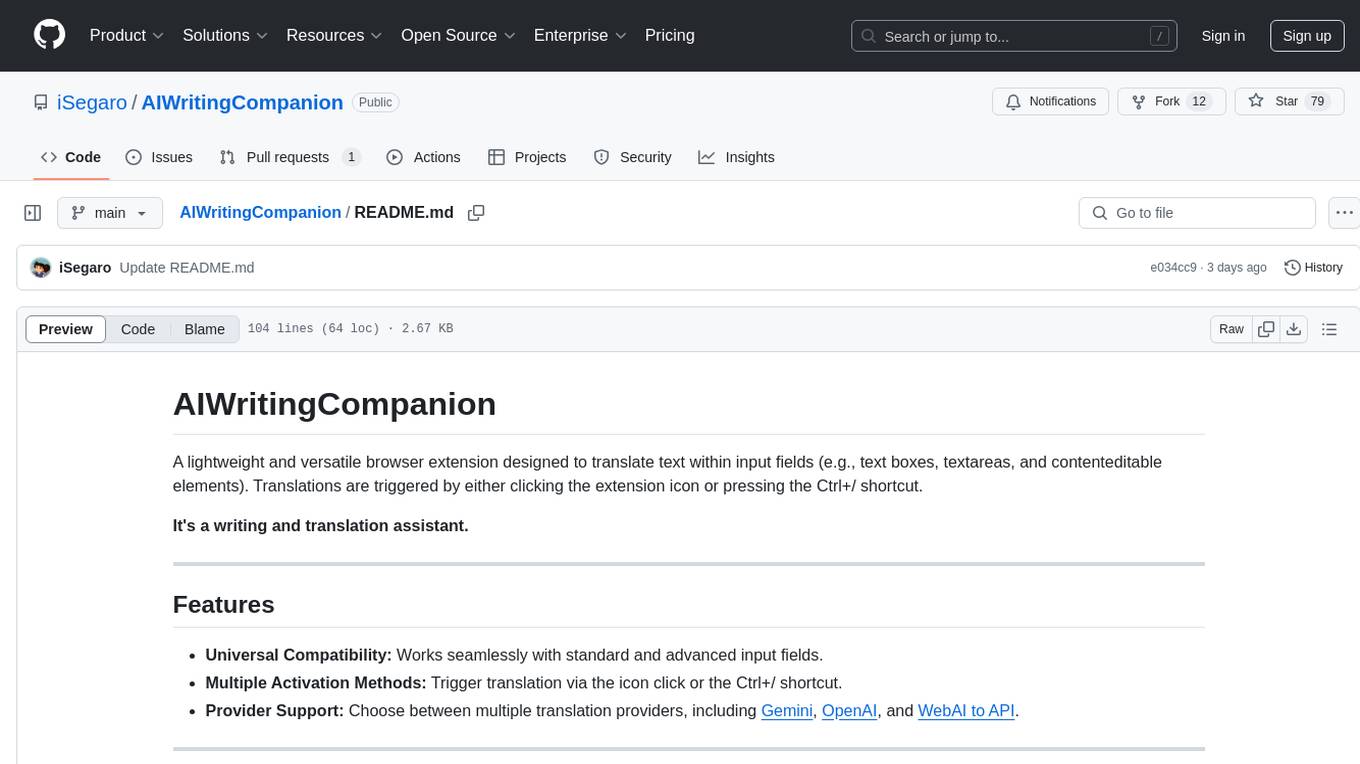
AIWritingCompanion
AIWritingCompanion is a lightweight and versatile browser extension designed to translate text within input fields. It offers universal compatibility, multiple activation methods, and support for various translation providers like Gemini, OpenAI, and WebAI to API. Users can install it via CRX file or Git, set API key, and use it for automatic translation or via shortcut. The tool is suitable for writers, translators, students, researchers, and bloggers. AI keywords include writing assistant, translation tool, browser extension, language translation, and text translator. Users can use it for tasks like translate text, assist in writing, simplify content, check language accuracy, and enhance communication.
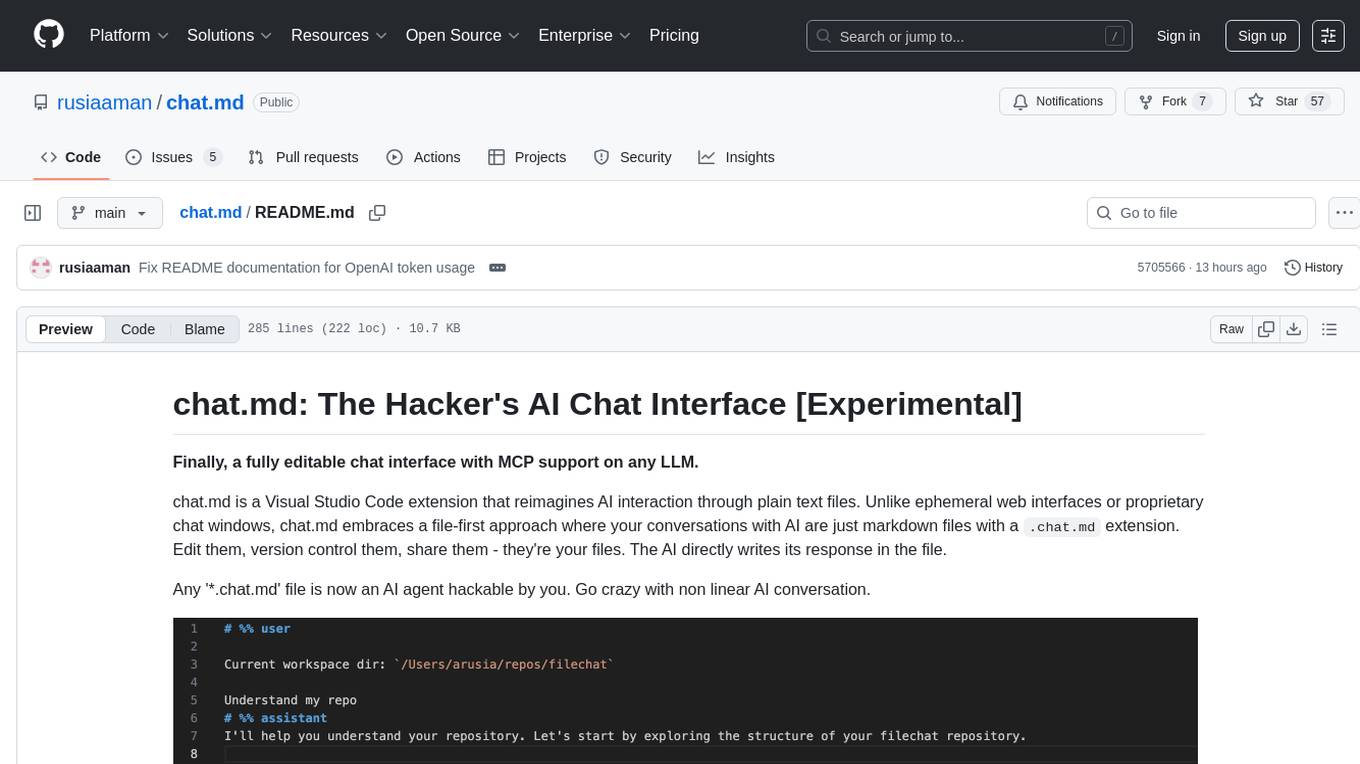
chat.md
This repository contains a chatbot tool that utilizes natural language processing to interact with users. The tool is designed to understand and respond to user input in a conversational manner, providing information and assistance. It can be integrated into various applications to enhance user experience and automate customer support. The chatbot tool is user-friendly and customizable, making it suitable for businesses looking to improve customer engagement and streamline communication.
For similar jobs
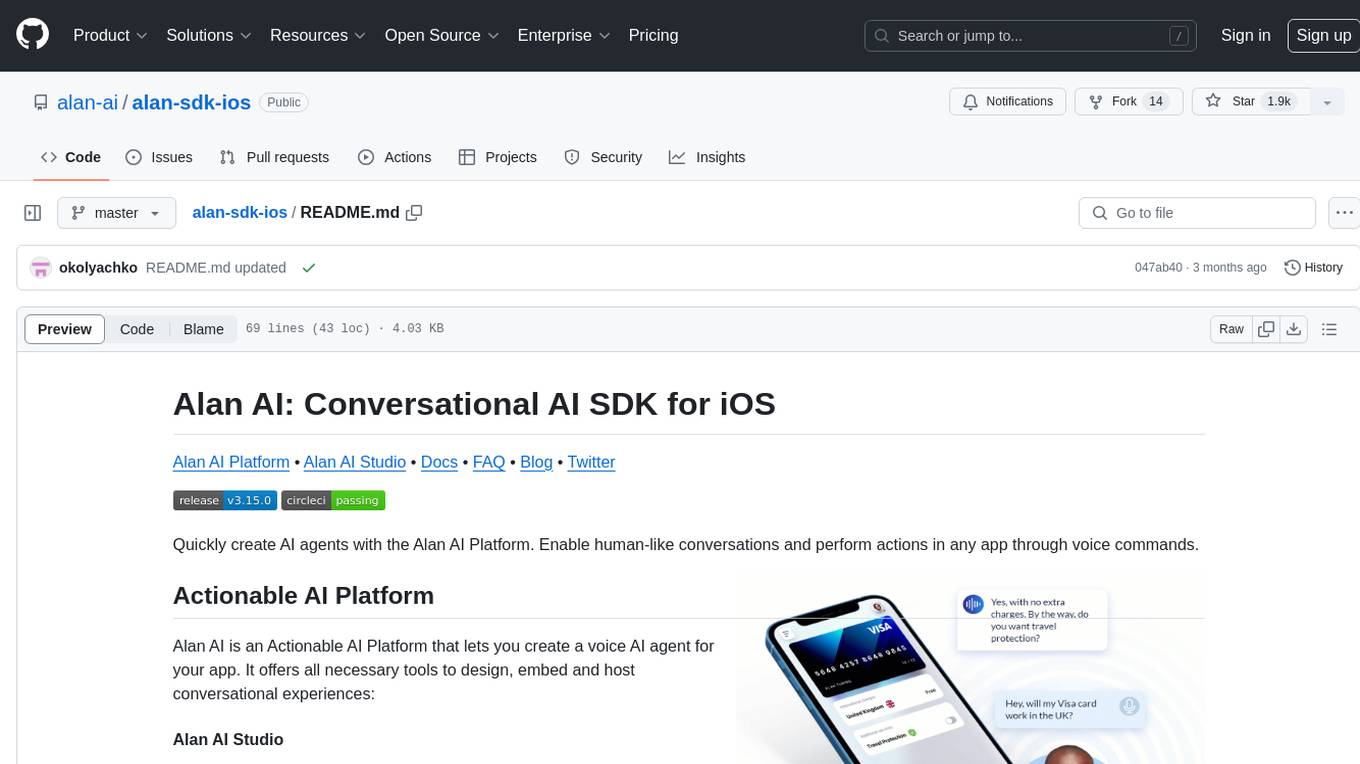
alan-sdk-ios
Alan AI SDK for iOS is a powerful tool that allows developers to quickly create AI agents for their iOS apps. With Alan AI Platform, users can easily design, embed, and host conversational experiences in their applications. The platform offers a web-based IDE called Alan AI Studio for creating dialog scenarios, lightweight SDKs for embedding AI agents, and a backend powered by top-notch speech recognition and natural language understanding technologies. Alan AI enables human-like conversations and actions through voice commands, with features like on-the-fly updates, dialog flow testing, and analytics.
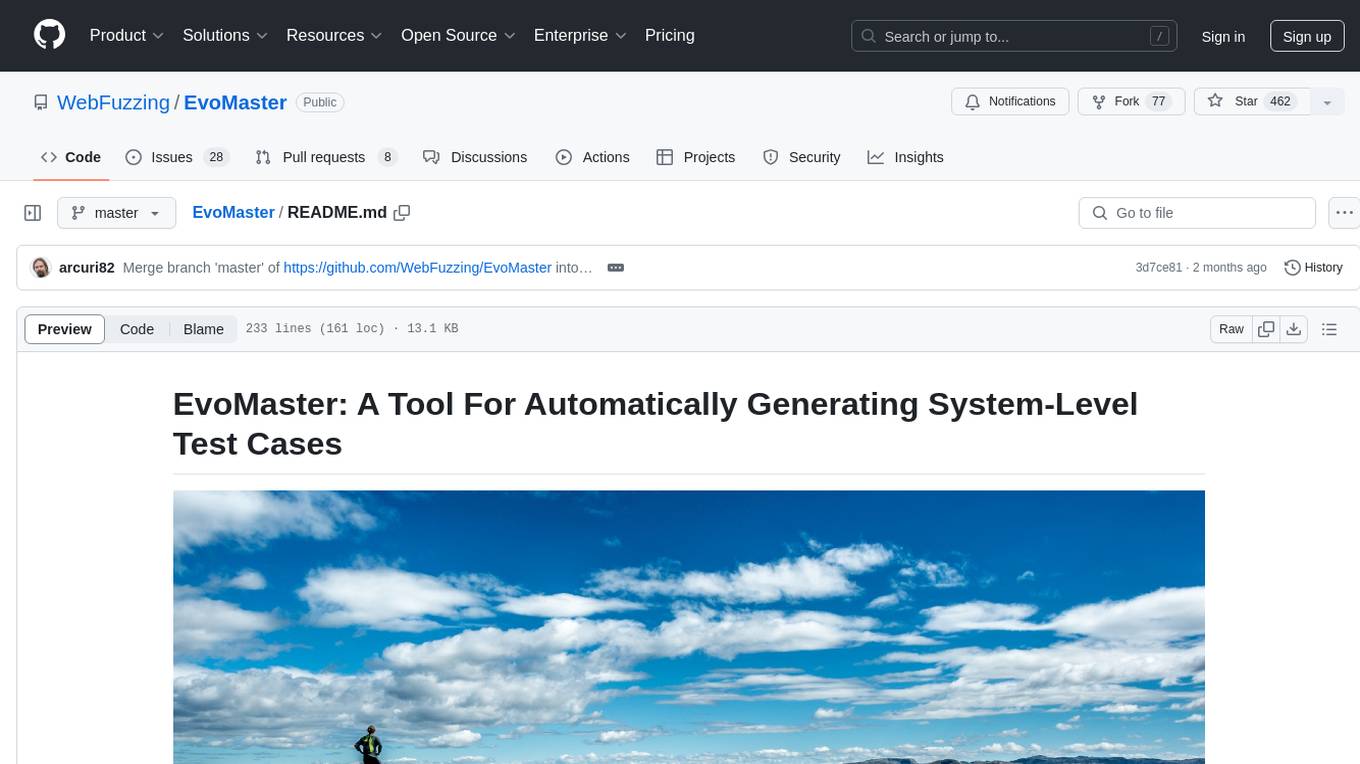
EvoMaster
EvoMaster is an open-source AI-driven tool that automatically generates system-level test cases for web/enterprise applications. It uses an Evolutionary Algorithm and Dynamic Program Analysis to evolve test cases, maximizing code coverage and fault detection. The tool supports REST, GraphQL, and RPC APIs, with whitebox testing for JVM-compiled languages. It generates JUnit tests, detects faults, handles SQL databases, and supports authentication. EvoMaster has been funded by the European Research Council and the Research Council of Norway.
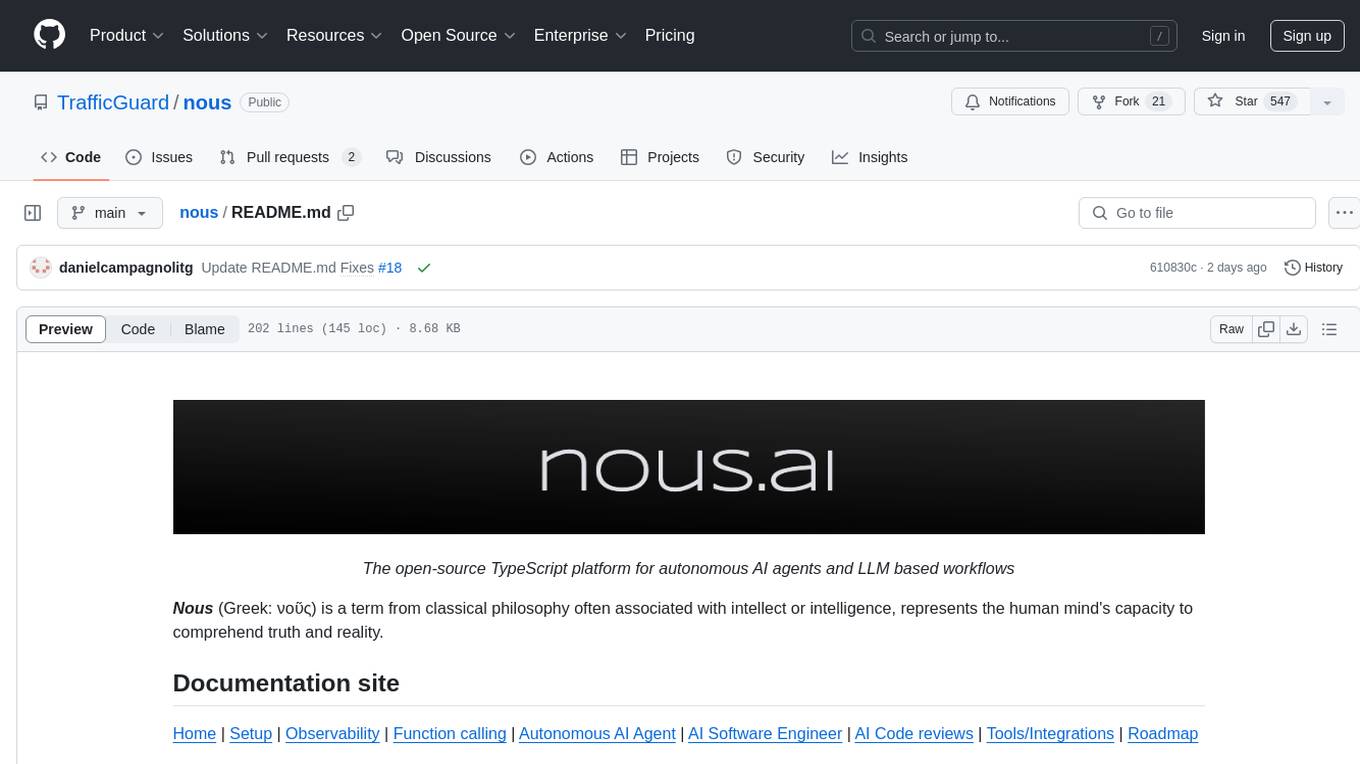
nous
Nous is an open-source TypeScript platform for autonomous AI agents and LLM based workflows. It aims to automate processes, support requests, review code, assist with refactorings, and more. The platform supports various integrations, multiple LLMs/services, CLI and web interface, human-in-the-loop interactions, flexible deployment options, observability with OpenTelemetry tracing, and specific agents for code editing, software engineering, and code review. It offers advanced features like reasoning/planning, memory and function call history, hierarchical task decomposition, and control-loop function calling options. Nous is designed to be a flexible platform for the TypeScript community to expand and support different use cases and integrations.
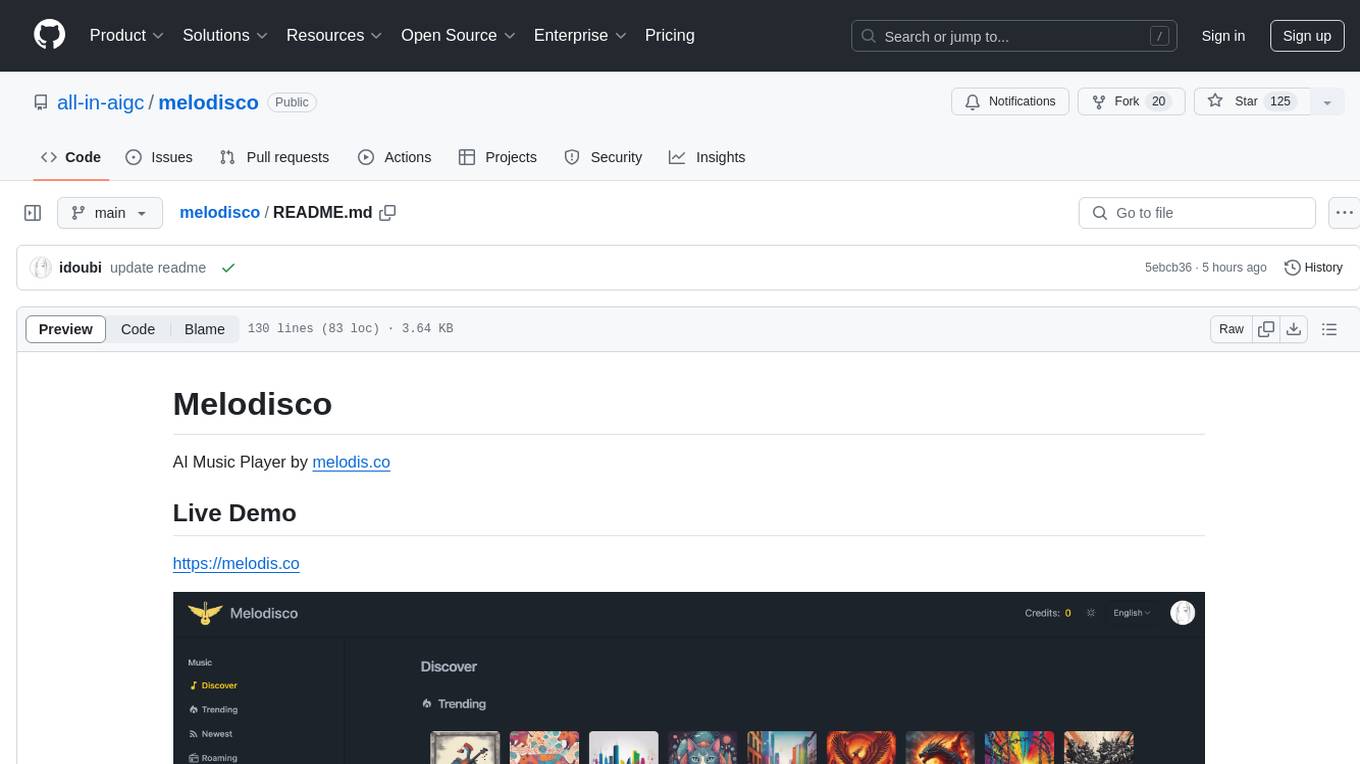
melodisco
Melodisco is an AI music player that allows users to listen to music and manage playlists. It provides a user-friendly interface for music playback and organization. Users can deploy Melodisco with Vercel or Docker for easy setup. Local development instructions are provided for setting up the project environment. The project credits various tools and libraries used in its development, such as Next.js, Tailwind CSS, and Stripe. Melodisco is a versatile tool for music enthusiasts looking for an AI-powered music player with features like authentication, payment integration, and multi-language support.
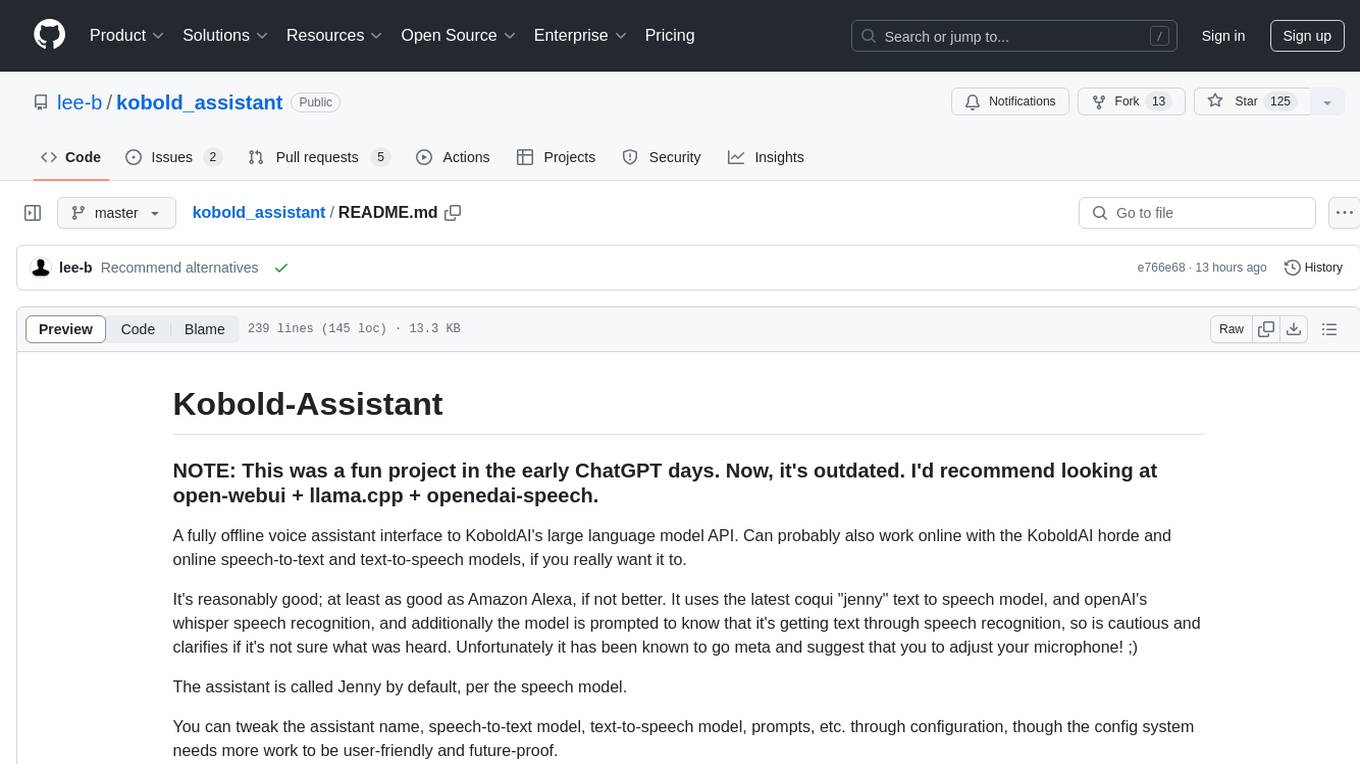
kobold_assistant
Kobold-Assistant is a fully offline voice assistant interface to KoboldAI's large language model API. It can work online with the KoboldAI horde and online speech-to-text and text-to-speech models. The assistant, called Jenny by default, uses the latest coqui 'jenny' text to speech model and openAI's whisper speech recognition. Users can customize the assistant name, speech-to-text model, text-to-speech model, and prompts through configuration. The tool requires system packages like GCC, portaudio development libraries, and ffmpeg, along with Python >=3.7, <3.11, and runs on Ubuntu/Debian systems. Users can interact with the assistant through commands like 'serve' and 'list-mics'.
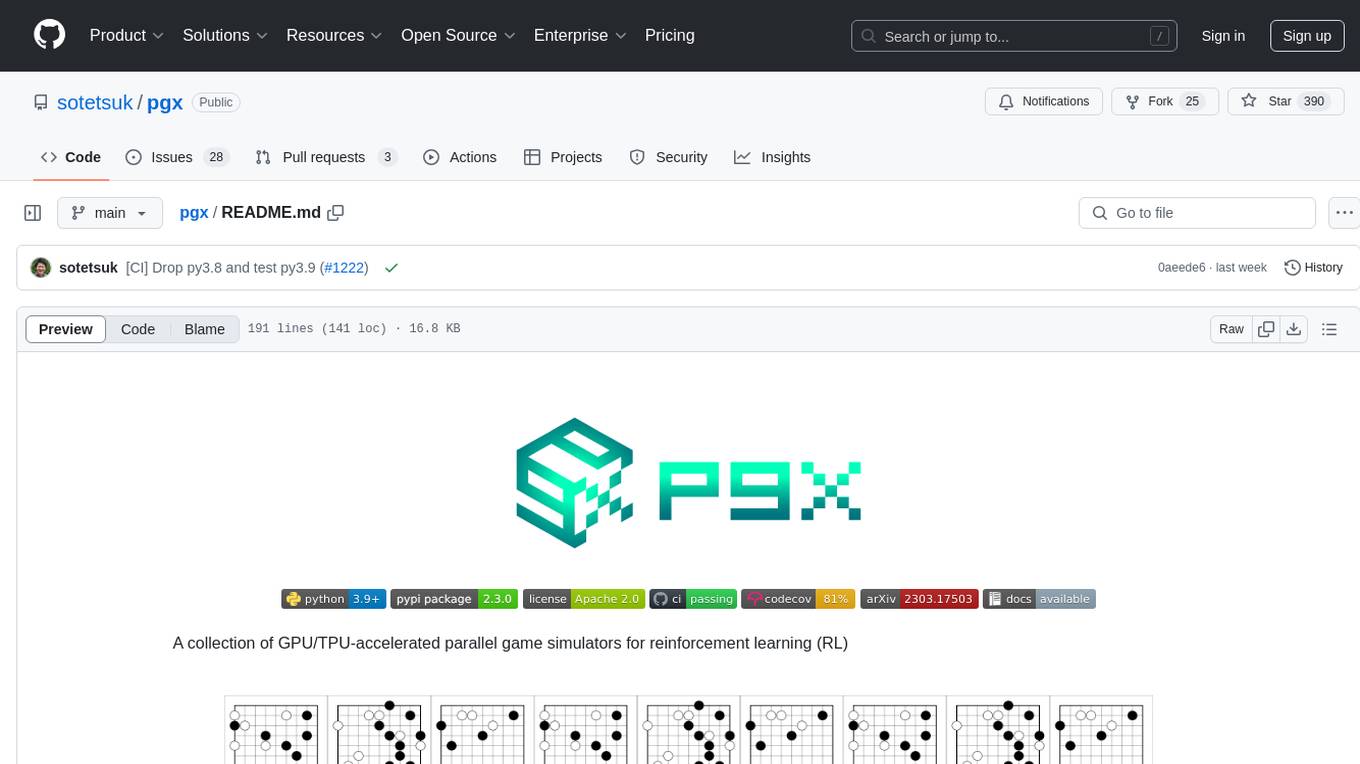
pgx
Pgx is a collection of GPU/TPU-accelerated parallel game simulators for reinforcement learning (RL). It provides JAX-native game simulators for various games like Backgammon, Chess, Shogi, and Go, offering super fast parallel execution on accelerators and beautiful visualization in SVG format. Pgx focuses on faster implementations while also being sufficiently general, allowing environments to be converted to the AEC API of PettingZoo for running Pgx environments through the PettingZoo API.
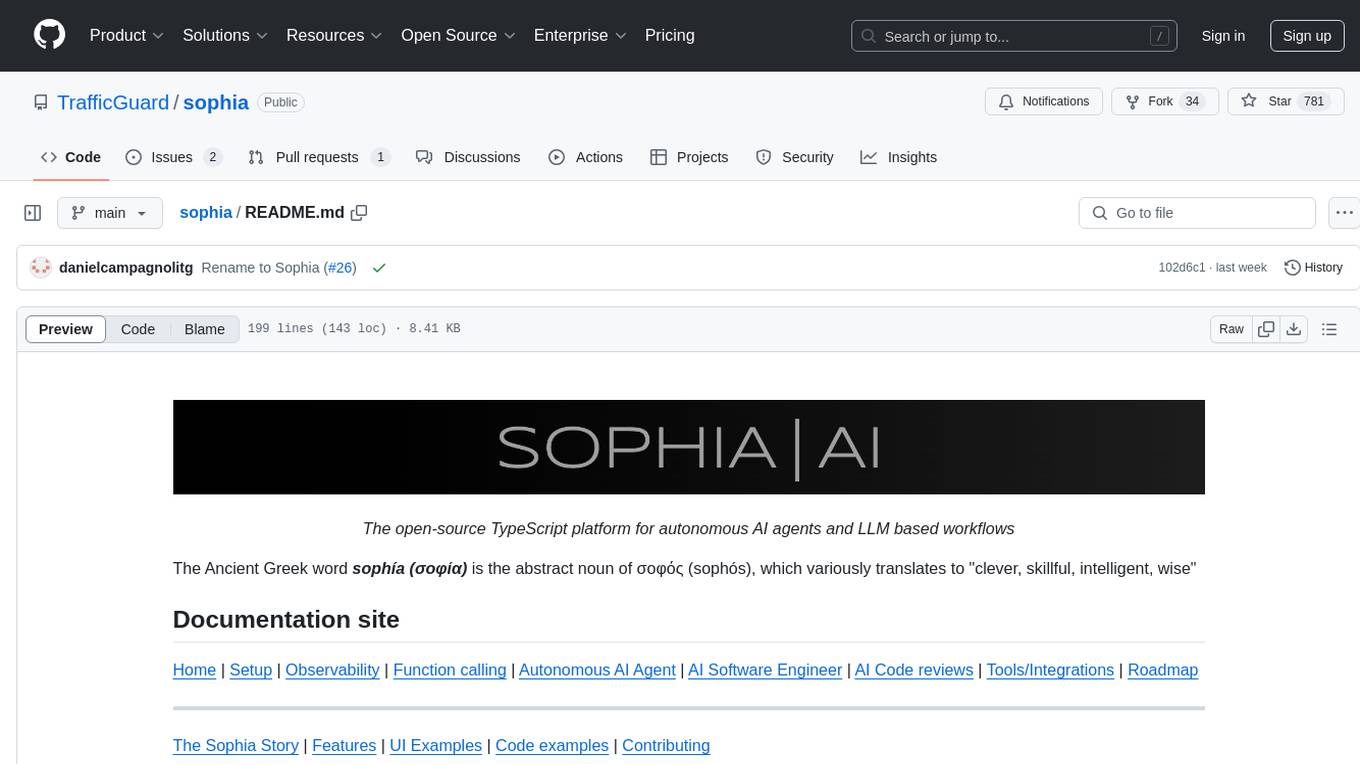
sophia
Sophia is an open-source TypeScript platform designed for autonomous AI agents and LLM based workflows. It aims to automate processes, review code, assist with refactorings, and support various integrations. The platform offers features like advanced autonomous agents, reasoning/planning inspired by Google's Self-Discover paper, memory and function call history, adaptive iterative planning, and more. Sophia supports multiple LLMs/services, CLI and web interface, human-in-the-loop interactions, flexible deployment options, observability with OpenTelemetry tracing, and specific agents for code editing, software engineering, and code review. It provides a flexible platform for the TypeScript community to expand and support various use cases and integrations.

skyeye
SkyEye is an AI-powered Ground Controlled Intercept (GCI) bot designed for the flight simulator Digital Combat Simulator (DCS). It serves as an advanced replacement for the in-game E-2, E-3, and A-50 AI aircraft, offering modern voice recognition, natural-sounding voices, real-world brevity and procedures, a wide range of commands, and intelligent battlespace monitoring. The tool uses Speech-To-Text and Text-To-Speech technology, can run locally or on a cloud server, and is production-ready software used by various DCS communities.